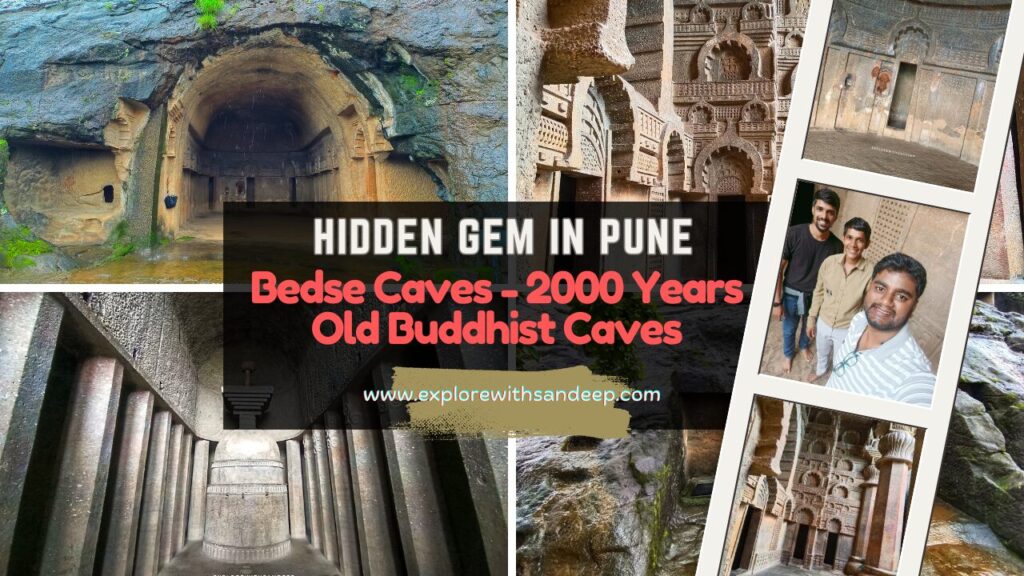Bedse Caves, Pune
Weekends always bring out the traveller in me. As soon as Saturday morning came, I felt that familiar itch to go somewhere new . While enjoying my morning chai, a thought popped into my head — “Wait! I’ve visited so many caves and forts around Pune, but there’s one place I still haven’t explored – Bedse Caves!”
That was it. The decision was made. I said to myself, “This is the last one left. Time to check it off the list! ✅”
Located near Kamshet, along the Pavana Lake road, Bedse Caves isn’t just another sightseeing spot. These caves are over 2,000 years old 🗿 and full of amazing ancient Indian art and rock-cut architecture. Hidden in the peaceful Sahyadri hills 🌿, they’re truly a gem 💎.
Without wasting time, I called my travel buddy Sachin and said, “Pack your bag – we’re going on a time-travel trip today! 🚀”
Bedse Caves History
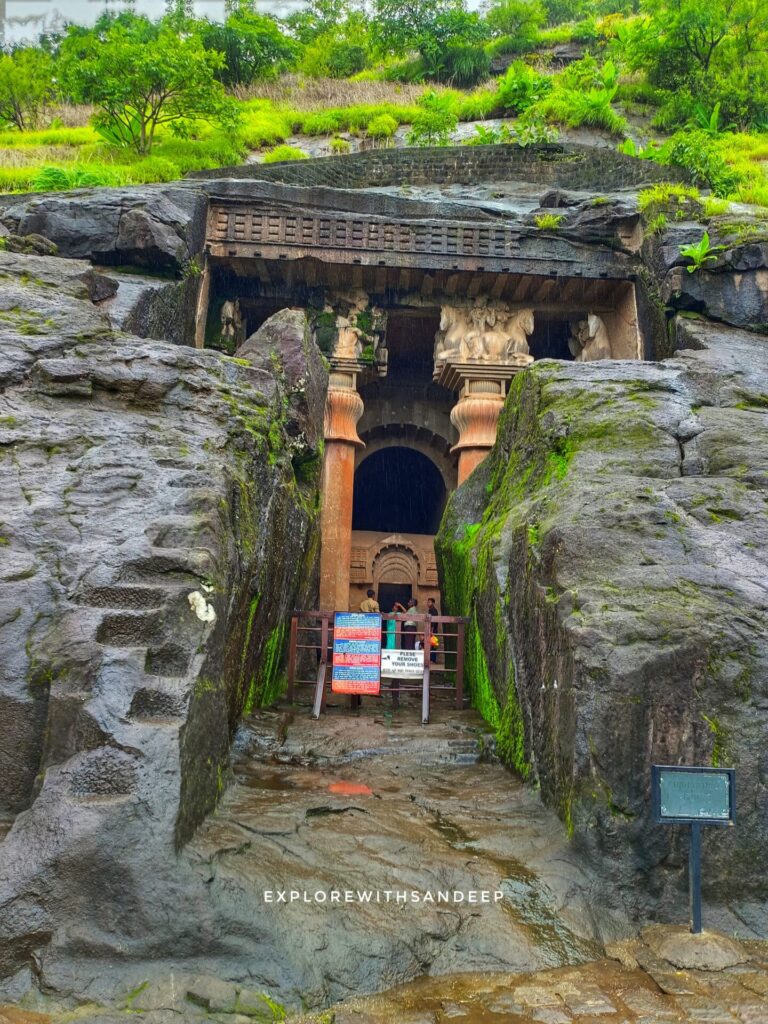
The Bedse Caves (also spelled Bedsa Caves) are over 2,000 years old, dating all the way back to the 1st century BCE during the time of the Satavahana dynasty. These caves were built as part of the Buddhist tradition, mainly for monks to meditate, pray, and stay during the rainy season.
The caves were carved directly into the hillside, using basic tools — no machines, no fancy equipment. And yet, the symmetry and carvings are so perfect, it’s hard to believe they were made so long ago!
There are mainly two important parts in Bedse Caves:
Chaitya Hall (Cave 7) – This was the prayer hall where monks used to meditate and walk around the large stupa, which is a symbol of peace and enlightenment.
Vihara (Cave 11) – This was the monks’ living area, where they rested, studied, and lived a peaceful life.
The caves also have beautiful carvings of animals like elephants, horses, and bulls, along with human figures wearing clothes and jewelry from that time. You can even see small stone windows and designs that look like wooden beams — but they’re actually carved from stone!
Until around the 1800s, Bedse Caves were regularly maintained and even painted, especially because British officers often visited. The local rulers kept the caves in good shape to impress their visitors. But over time, the site became less popular and is now a hidden gem — still standing strong, but away from the tourist crowd.
Today, the Archaeological Survey of India (ASI) looks after the caves and helps preserve this amazing piece of our history.
The Journey Begins – Waterfalls, Hills & Mahadev’s Blessings 🛣️🌧️
Sachin and I decided to go without a second thought. We packed our bags and started our journey from Pune at 10 AM. We took the route from Katraj to Balewadi, then headed straight to Kamshet. After around 1.5 hours, we reached the Kamshet bridge. Before taking the turn towards Bedse, we stopped for a quick cup of chai☕— the ultimate energy drink for every travel lover! With that boost of desi caffeine, we took the left turn — and that’s when the magic began! ✨
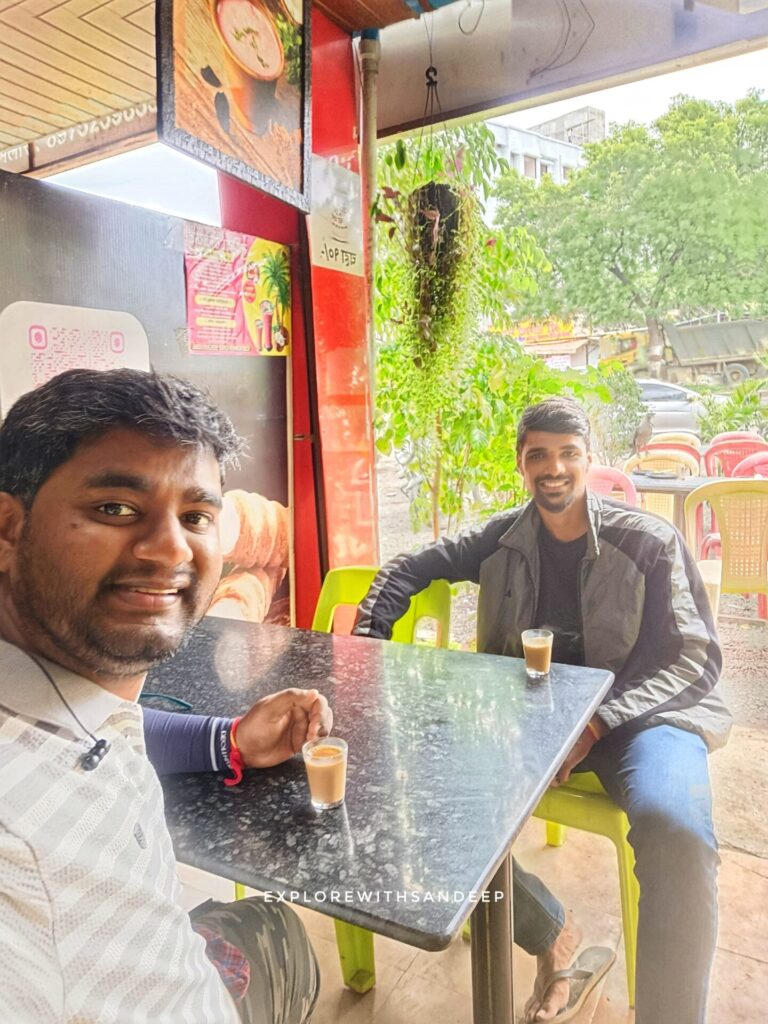
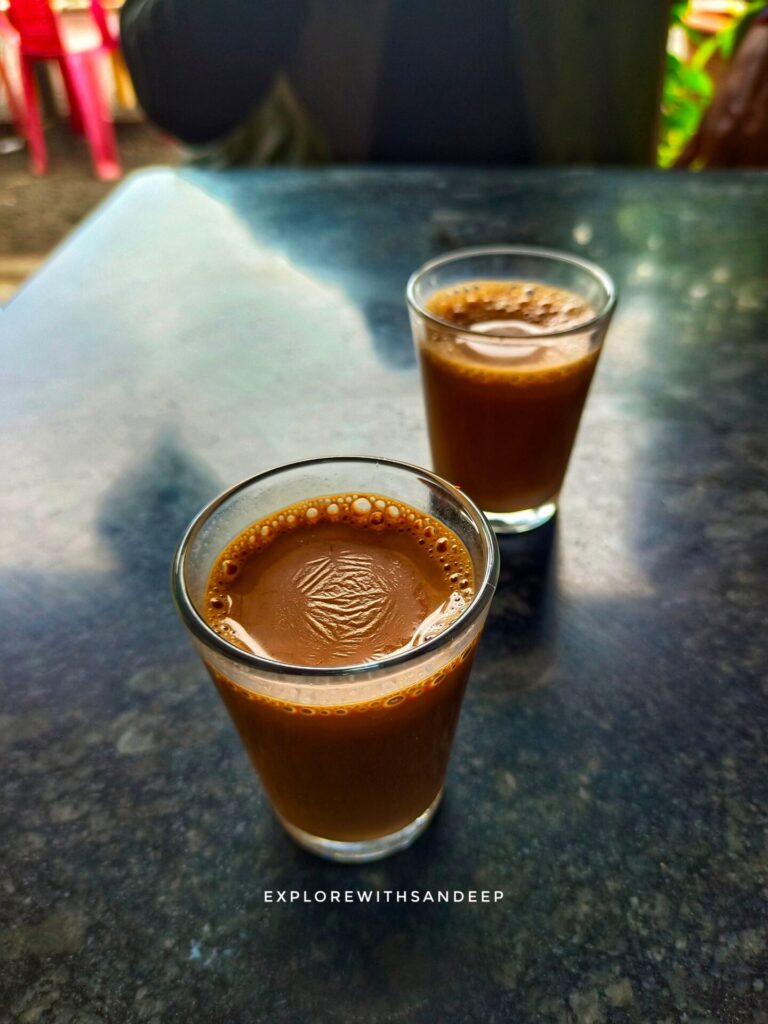
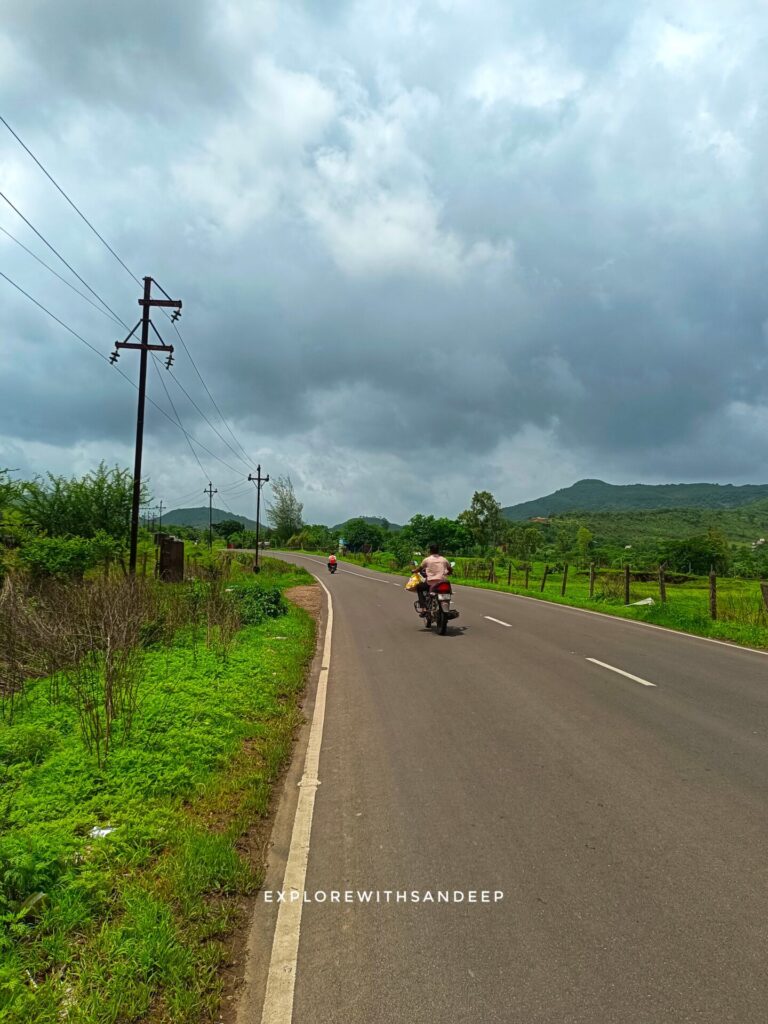
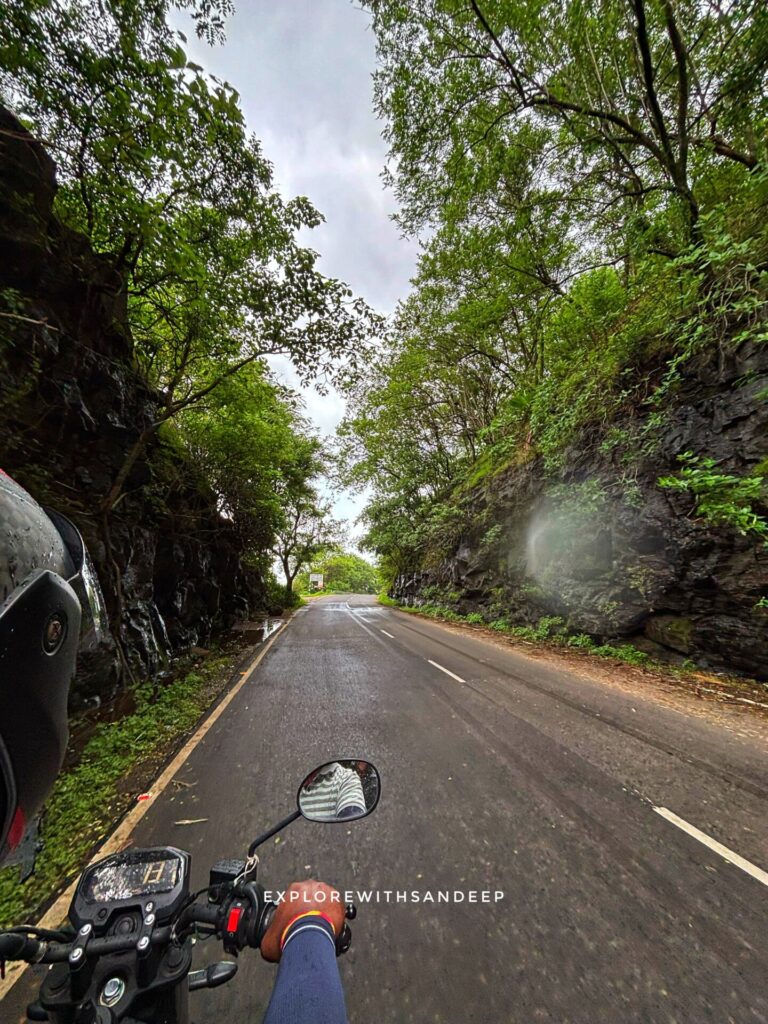
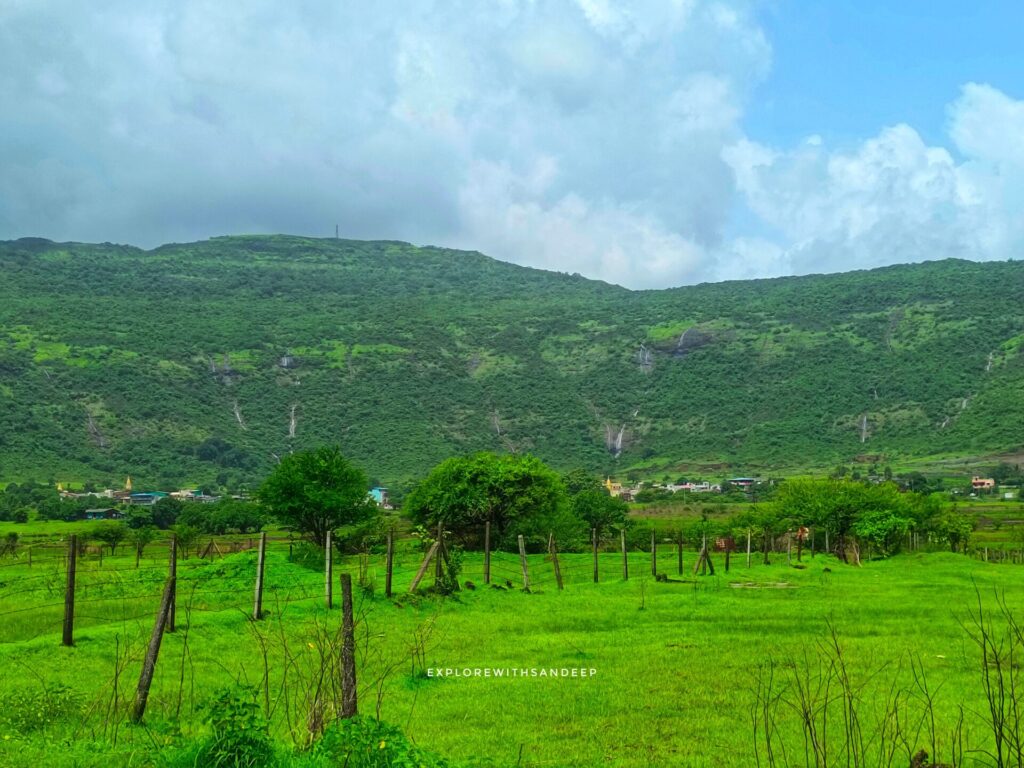
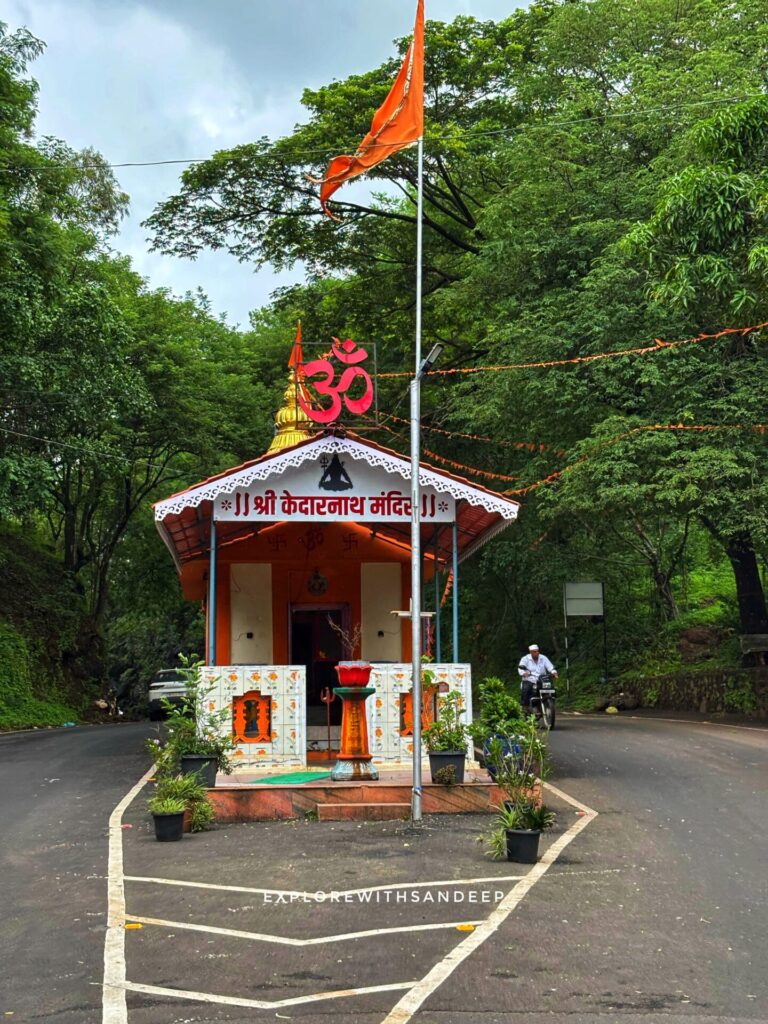

On the way, we came across a lovely temple – Kedarnath Mandir 🛕 – right in the middle of the road. We stopped, took blessings from Mahadev 🙏, and continued our ride towards Bedse Caves.
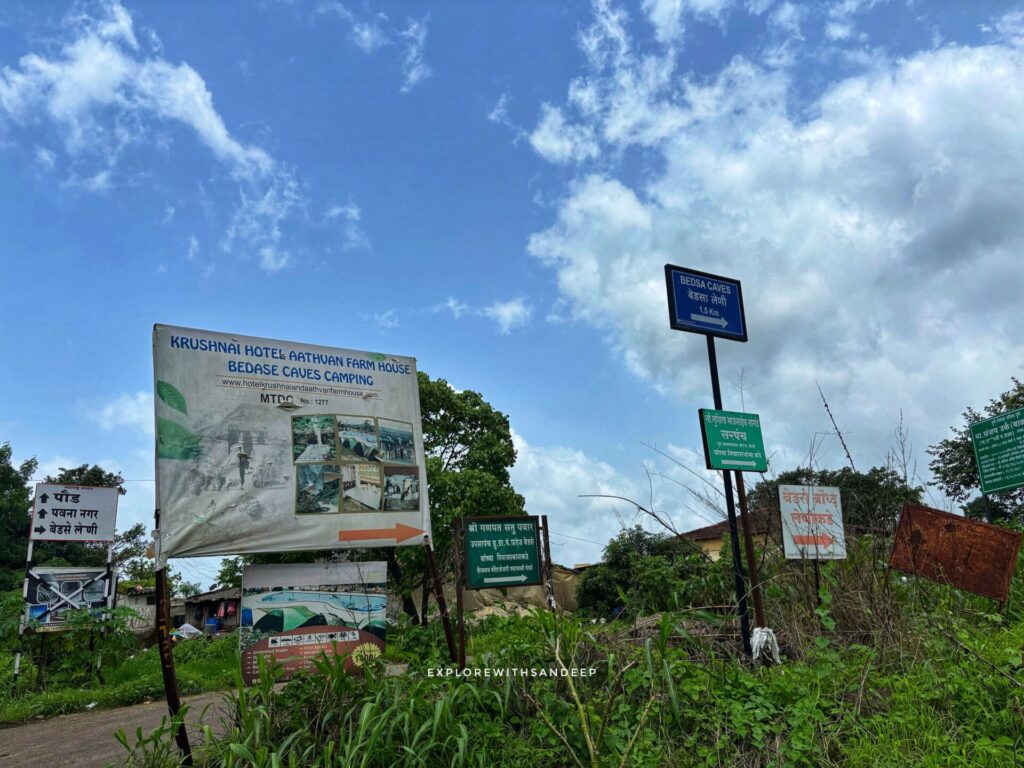
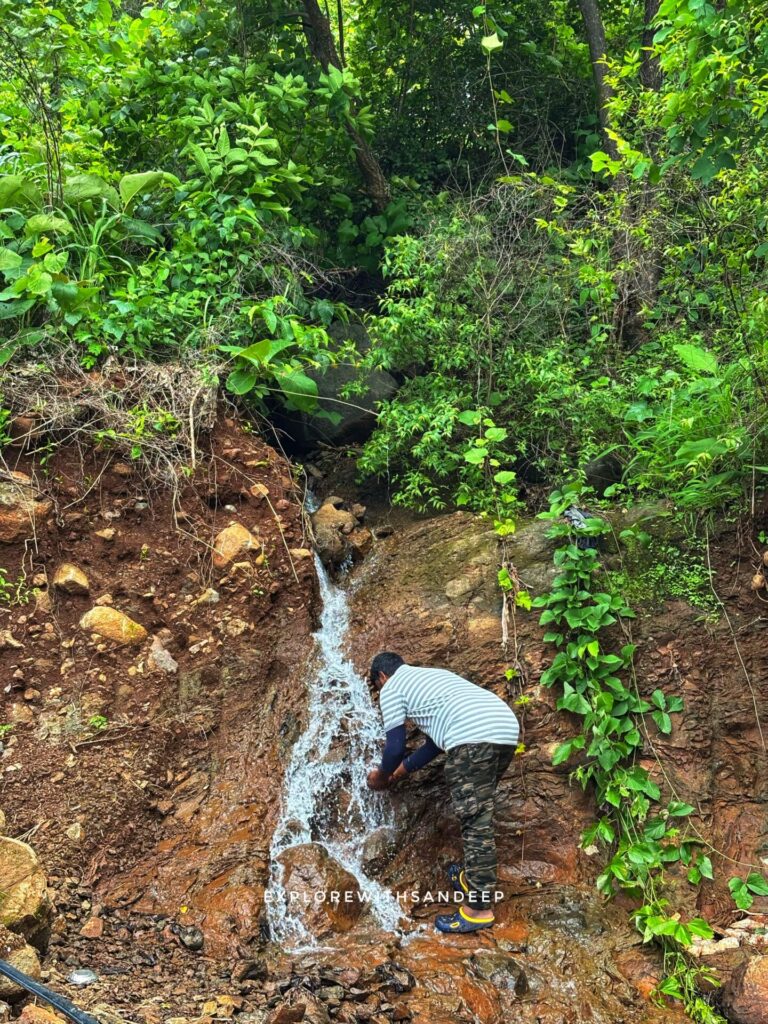
After 30 more minutes of riding through peaceful greenery, we reached the parking area. A small waterfall nearby was flowing gently, and we used its cool water to wash our faces. That moment felt like heaven 😌 – all our tiredness disappeared instantly.
Climbing to Bedse Caves – 400 Steps of Pure Adventure
Then came the real challenge – the climb! From the bottom, I confidently thought, “This must be just 50–60 steps.” Oh, how wrong I was 😅.
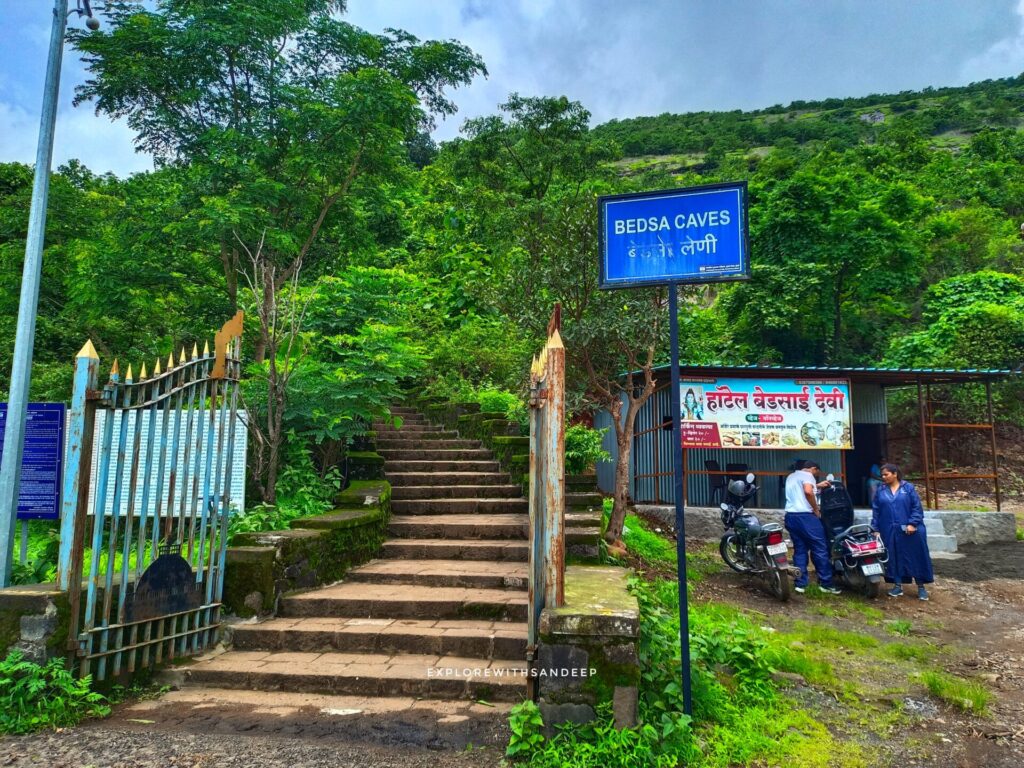
Bedse Caves have nearly 400 stone steps, and it took us almost 30 minutes to reach the top. But the journey was totally worth it! On the way, we crossed small streams of chilled mountain water 💧 flowing over the stairs. At a few spots, we dipped our feet – and honestly, it felt like nature’s own foot spa.
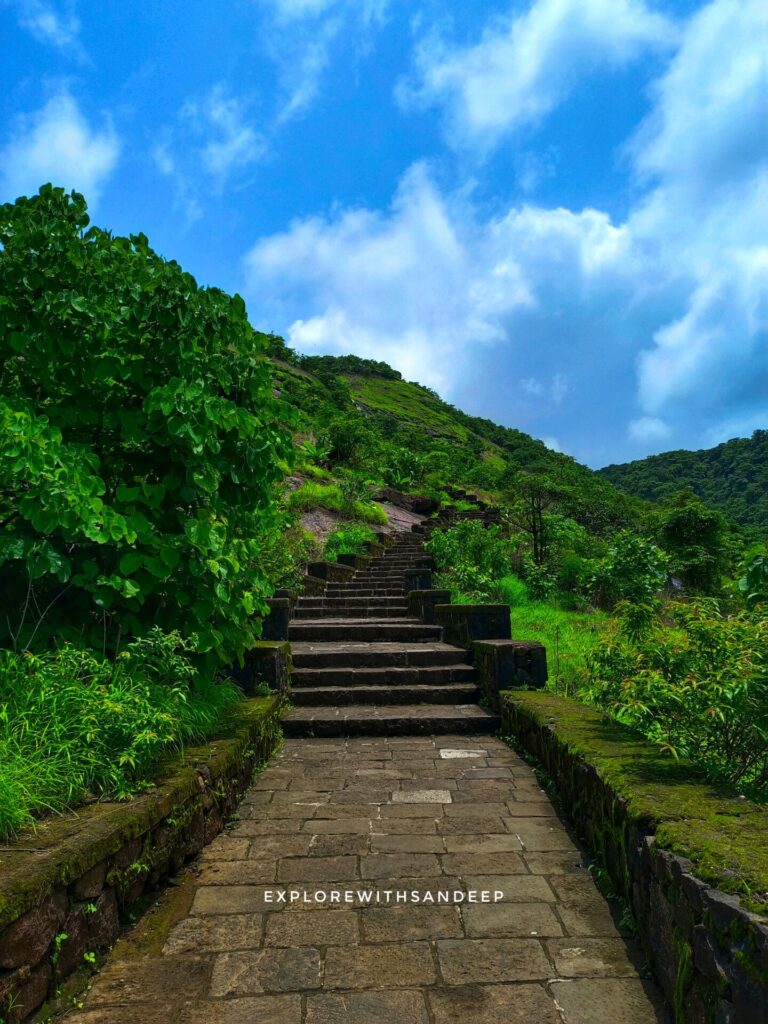
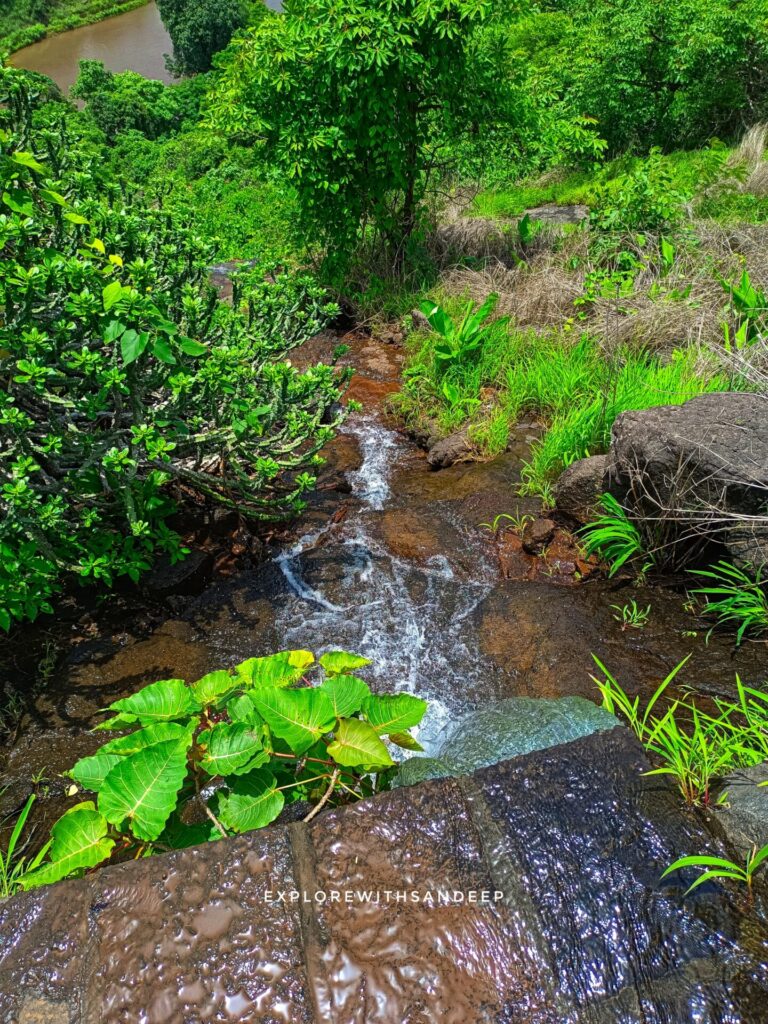
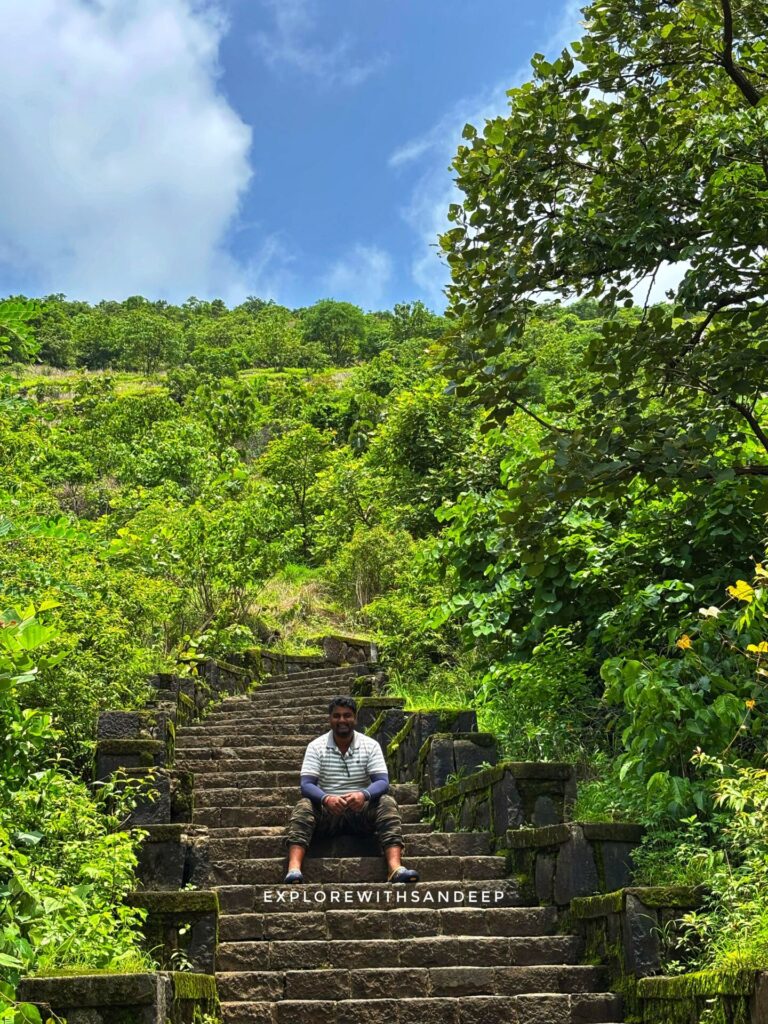
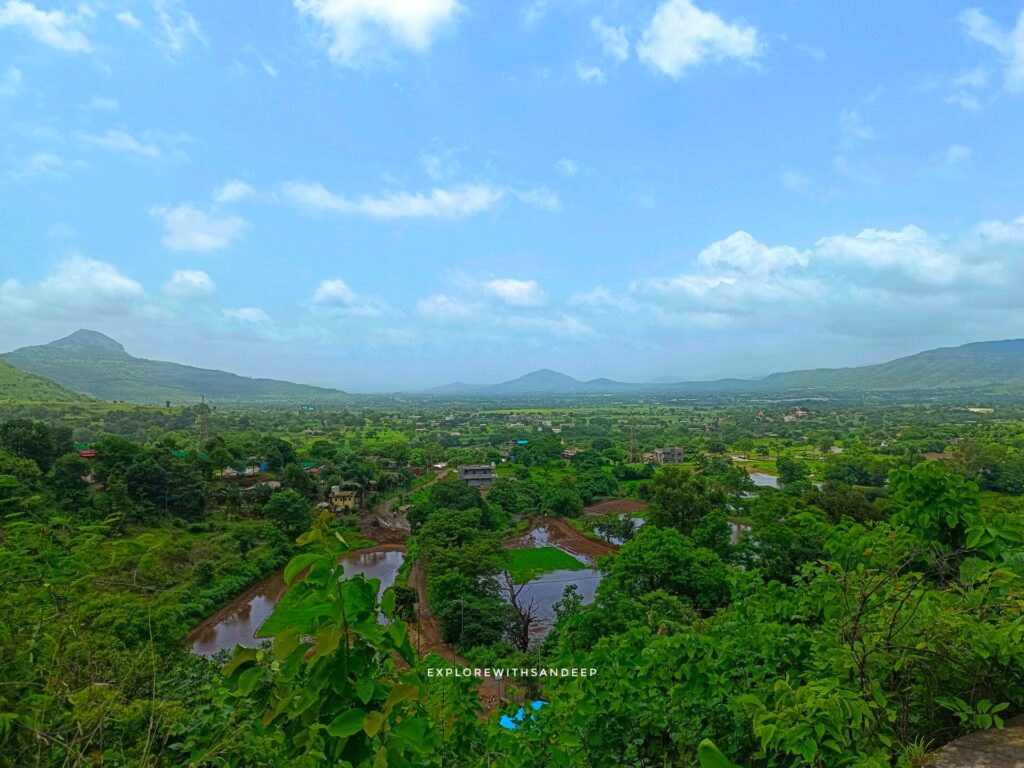
As we finally reached the entrance, the view of village from that entry took our breath away – pure village vibes, peaceful surroundings, and the crisp, fresh mountain air. It already felt like a different world – calm, quiet, and full of history.
Exploring Bedse Caves – History Carved in Stone
After reaching the top, the first thing we noticed was the peace – no noise, no crowd, just a calm breeze and ancient silence. At first glance, the caves looked quite plain. But as we moved closer, we started seeing the magic – the carvings and detailing were just mind-blowing!
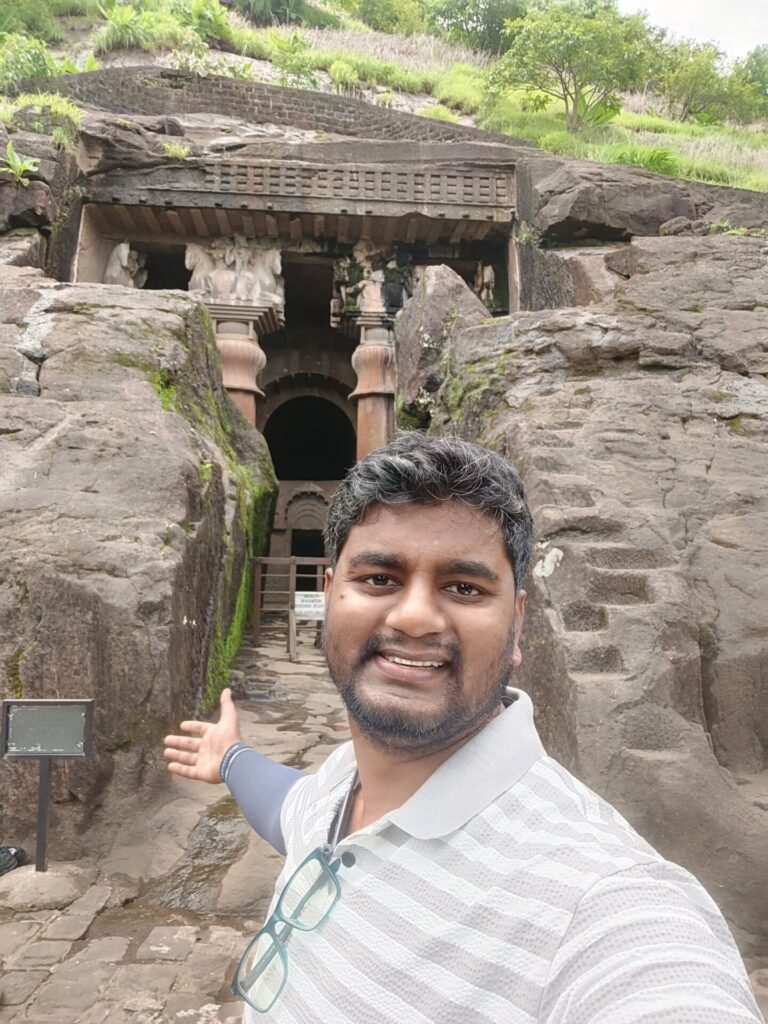
The Chaitya Hall – Cave 7
This is the main highlight of Bedse Caves. The entry to this ancient prayer hall is through a narrow rock-cut path, which makes it feel like you’re stepping into something special. It felt just like those grand fort entrances in movies – where you only get a sneak peek from outside, but the full view hits you only after you walk in. And believe me, what we saw inside was just wow!
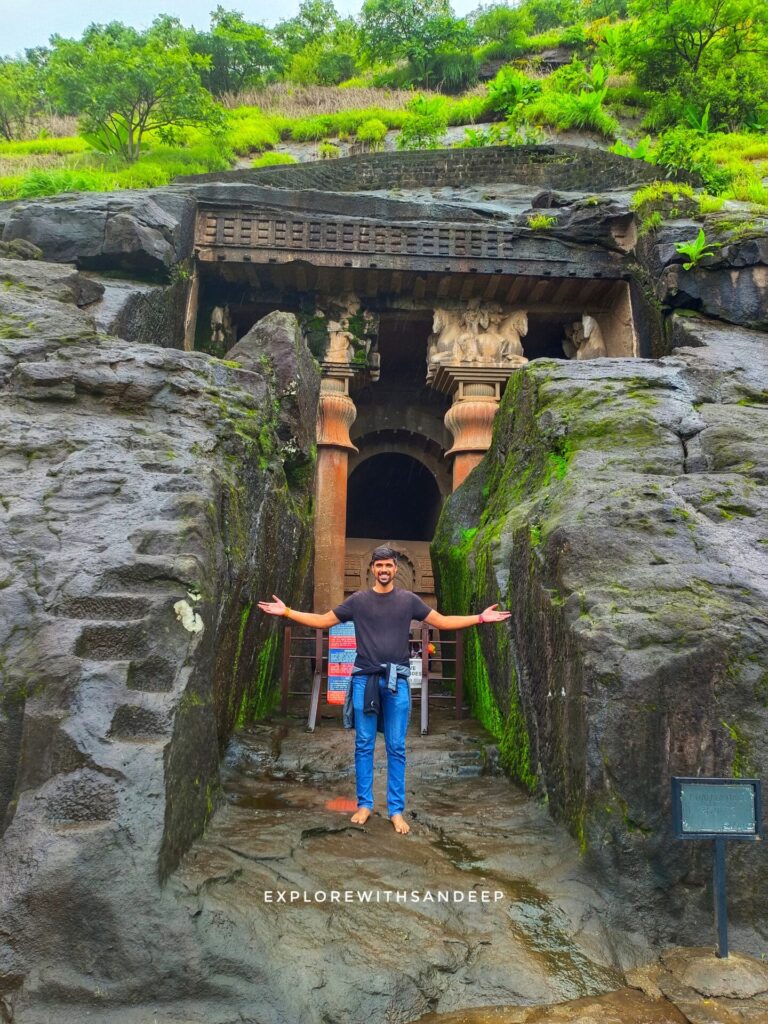
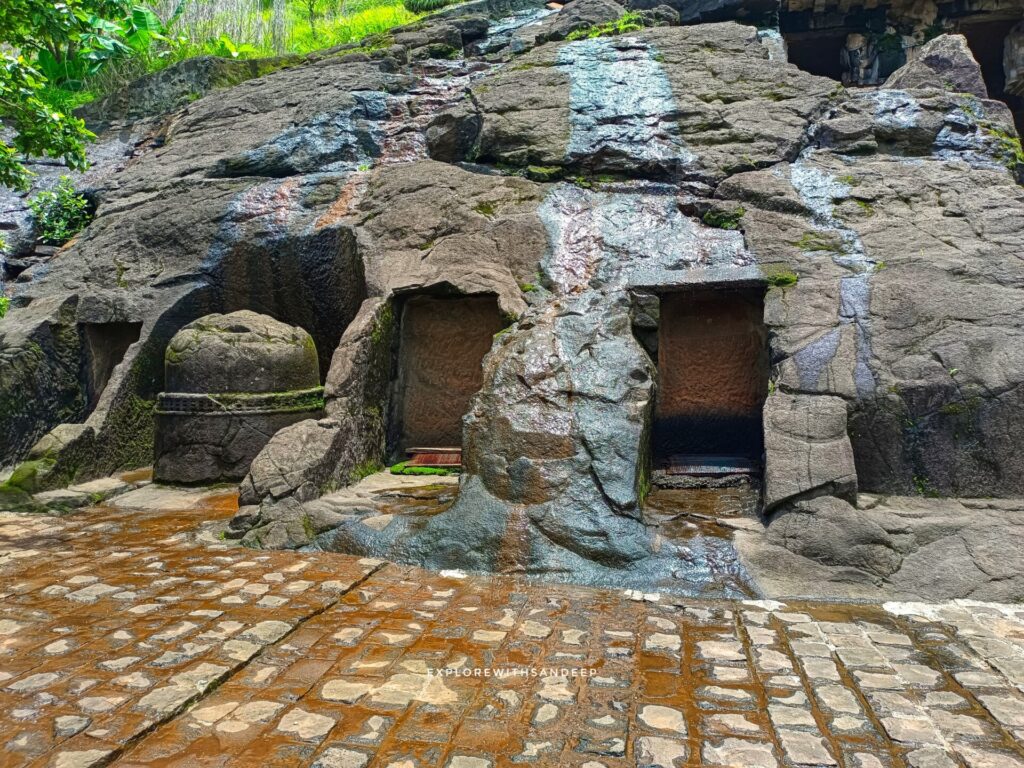
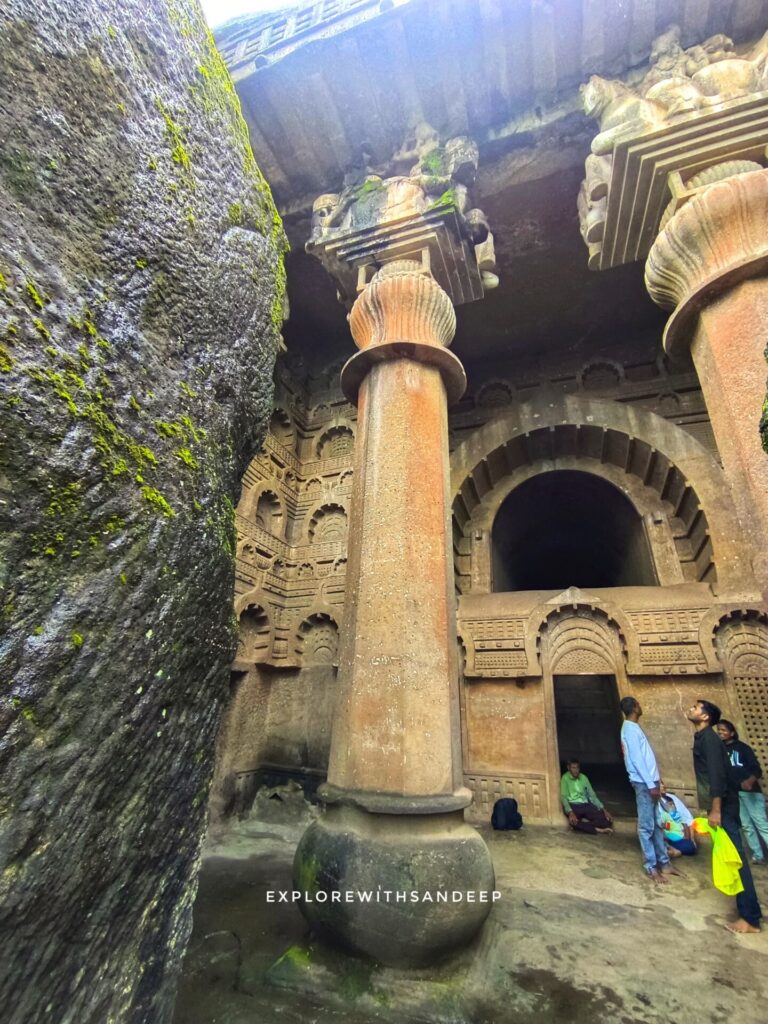
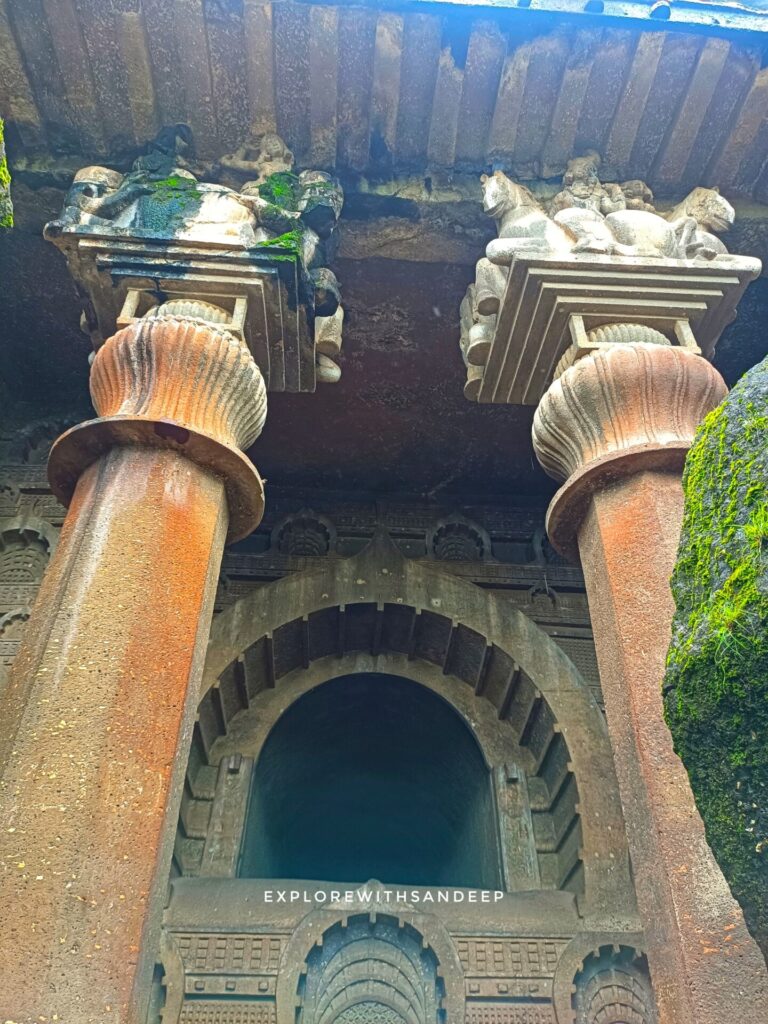
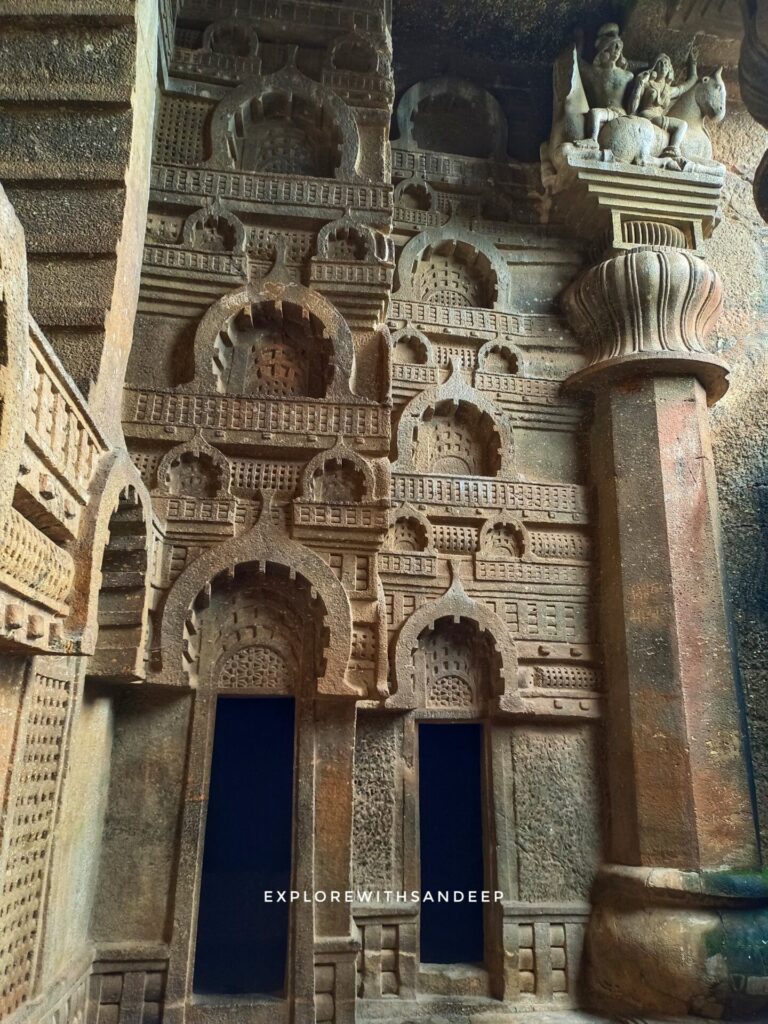
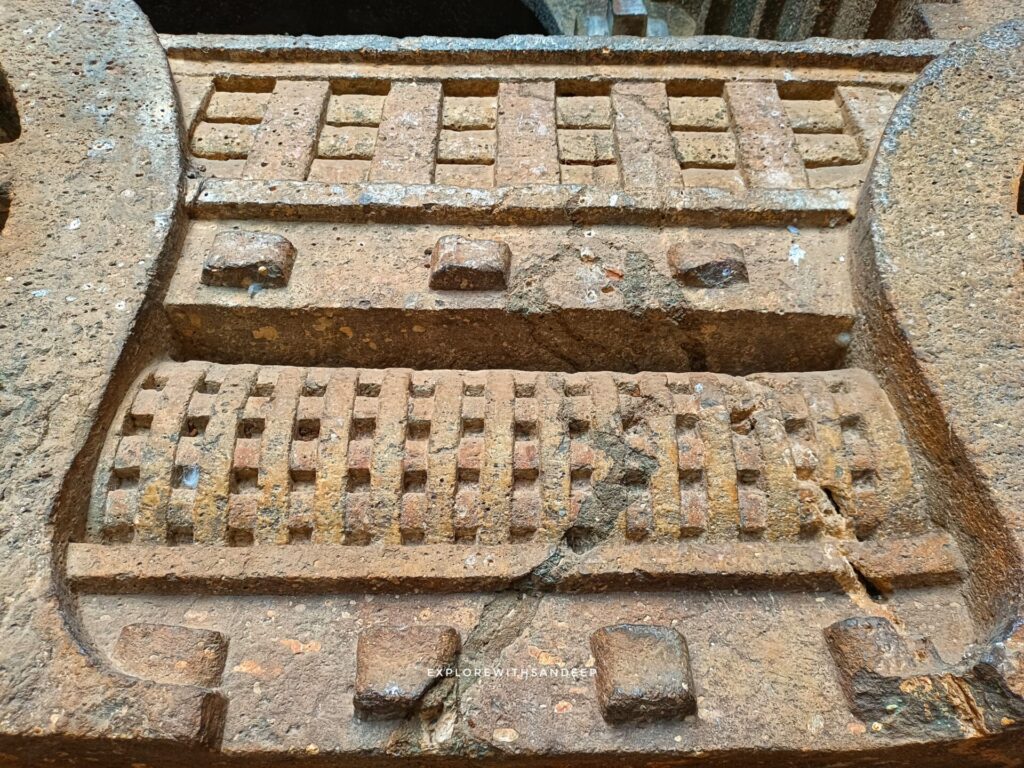
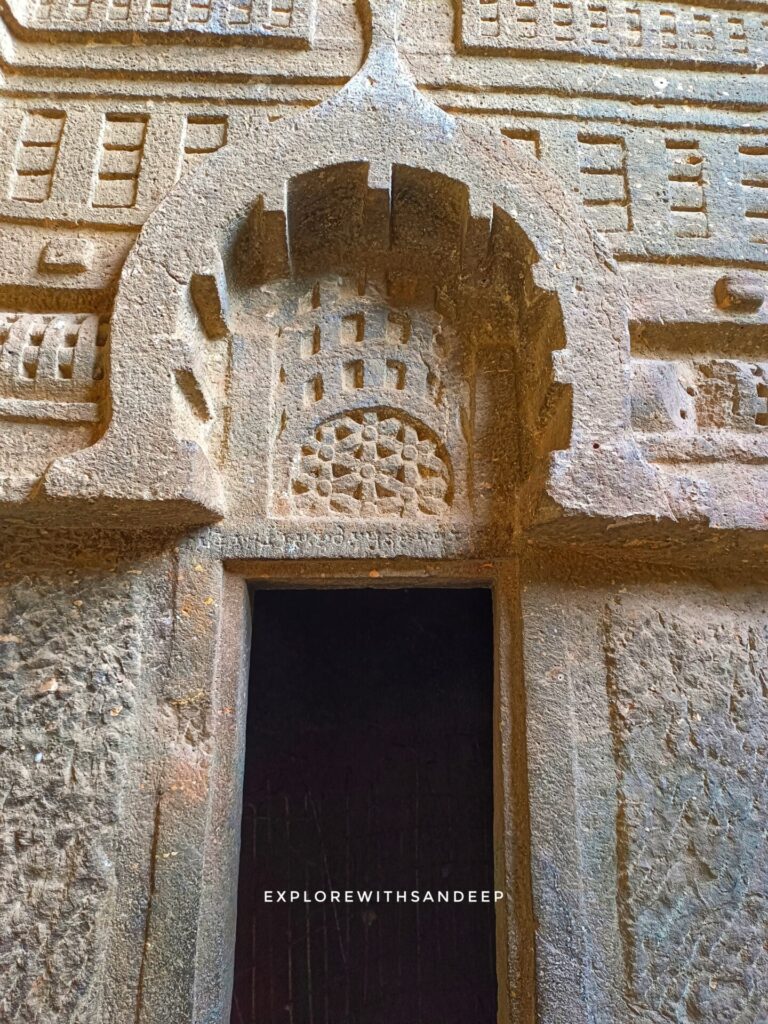
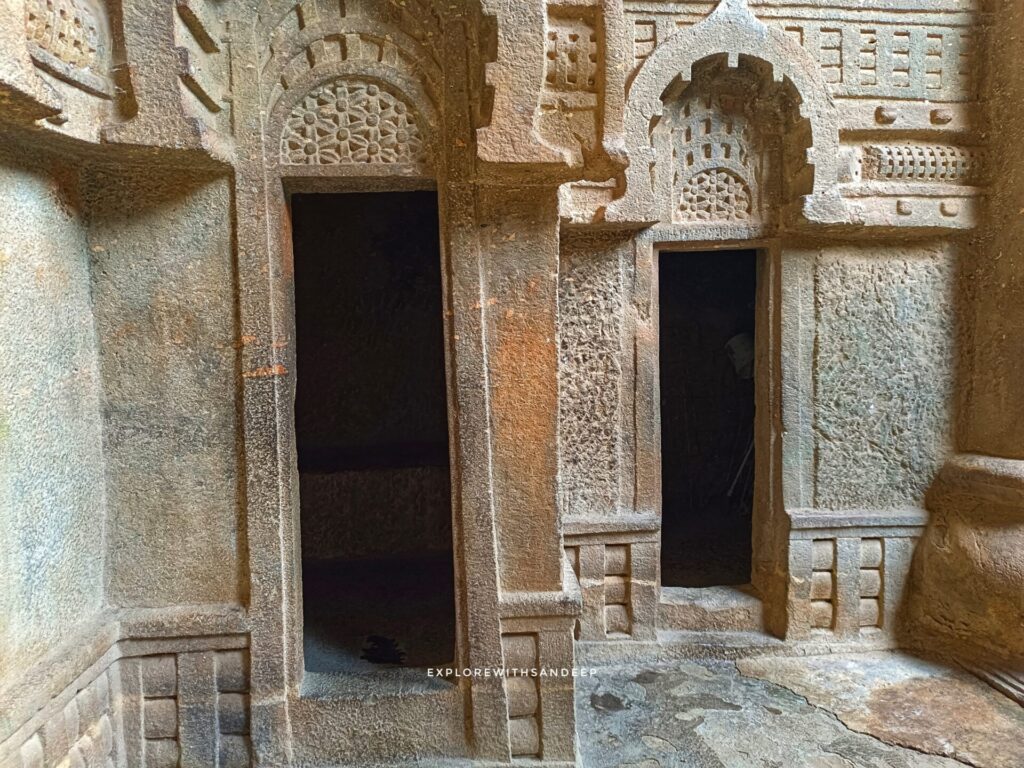
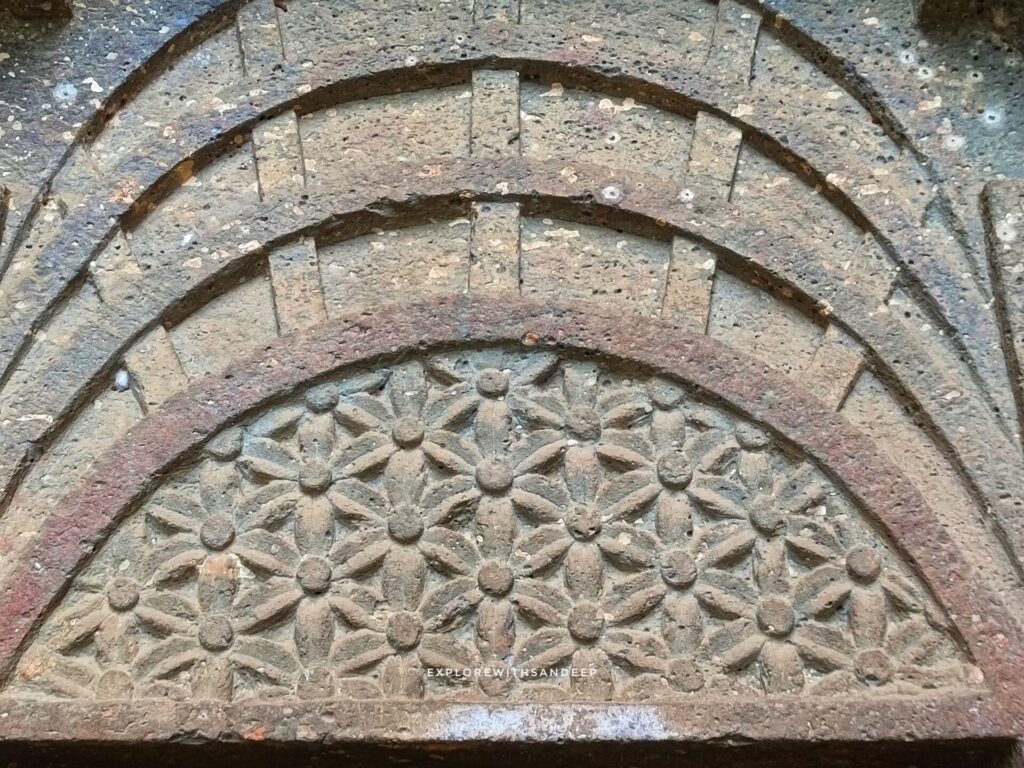
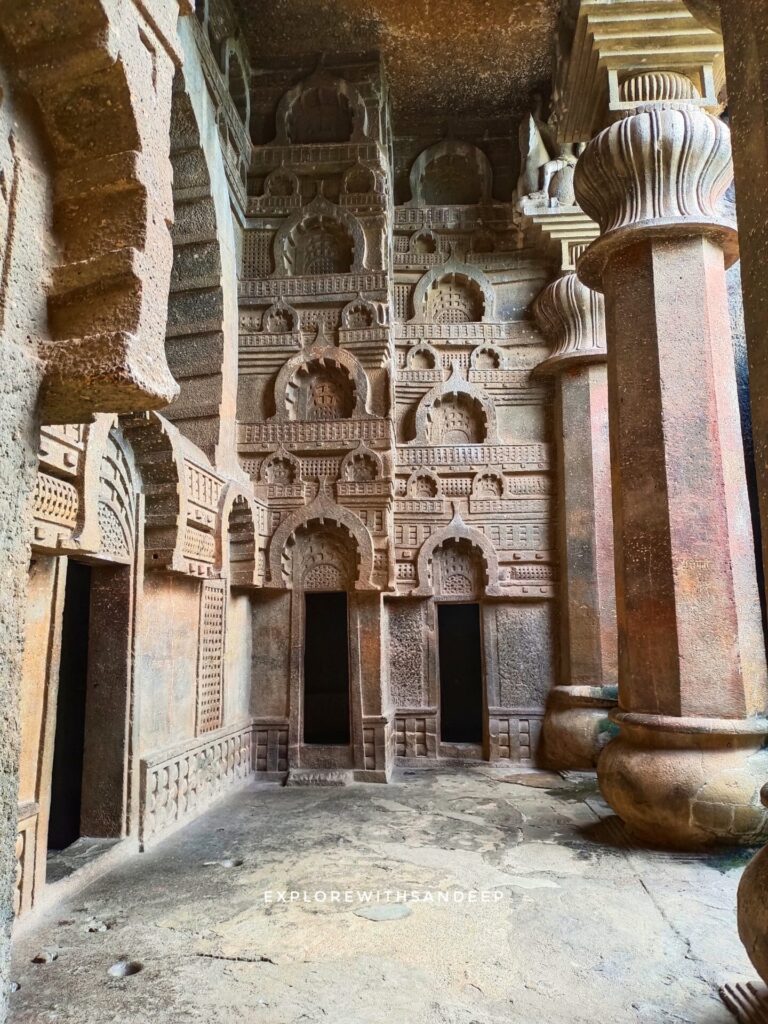
The outer verandah has four tall stone pillars, shaped like octagons. These aren’t just plain pillars – they have amazing carvings of animals with couples riding them. Looks like even 2,000 years ago, people loved adventure rides! 🐘🐎
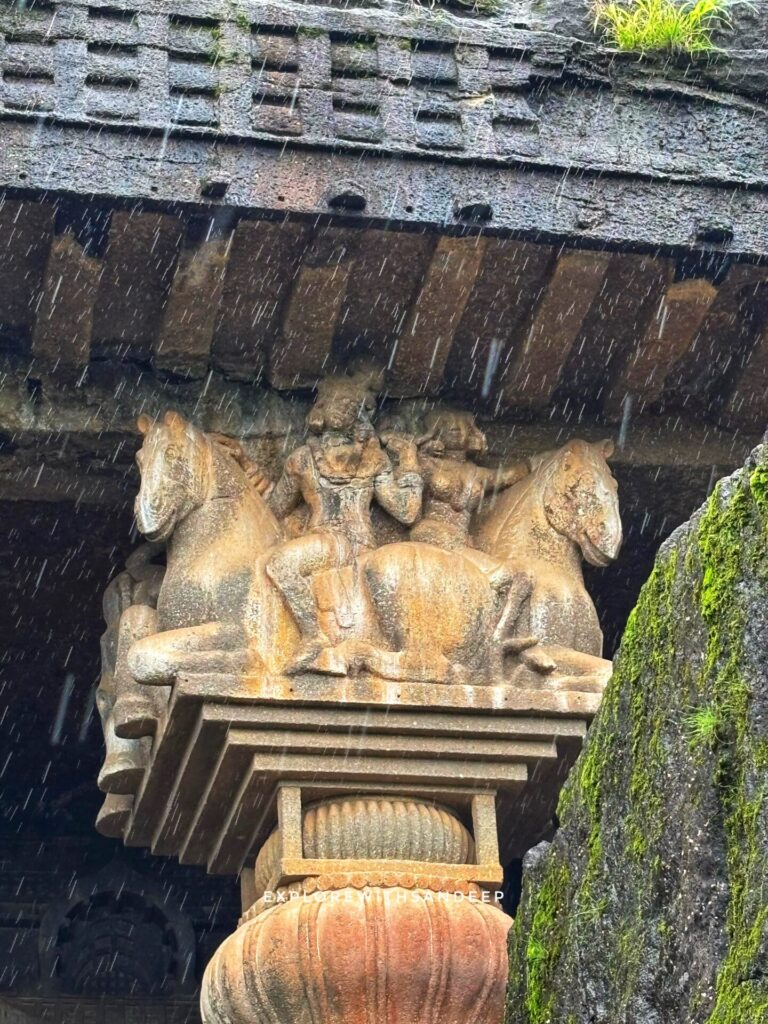
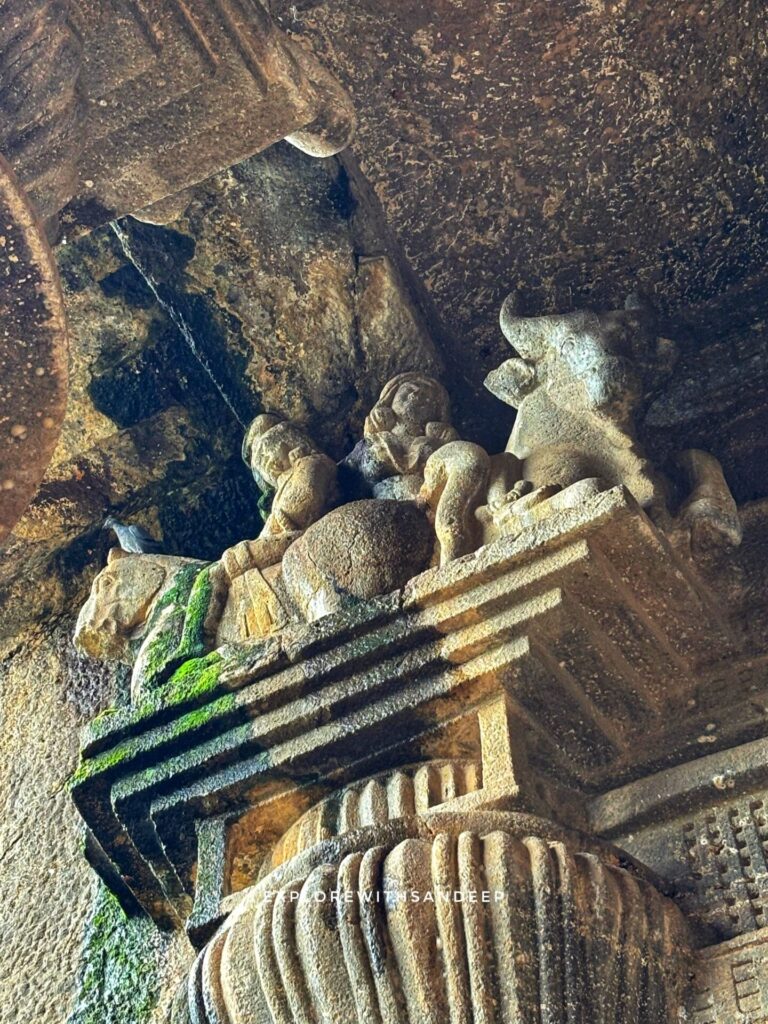
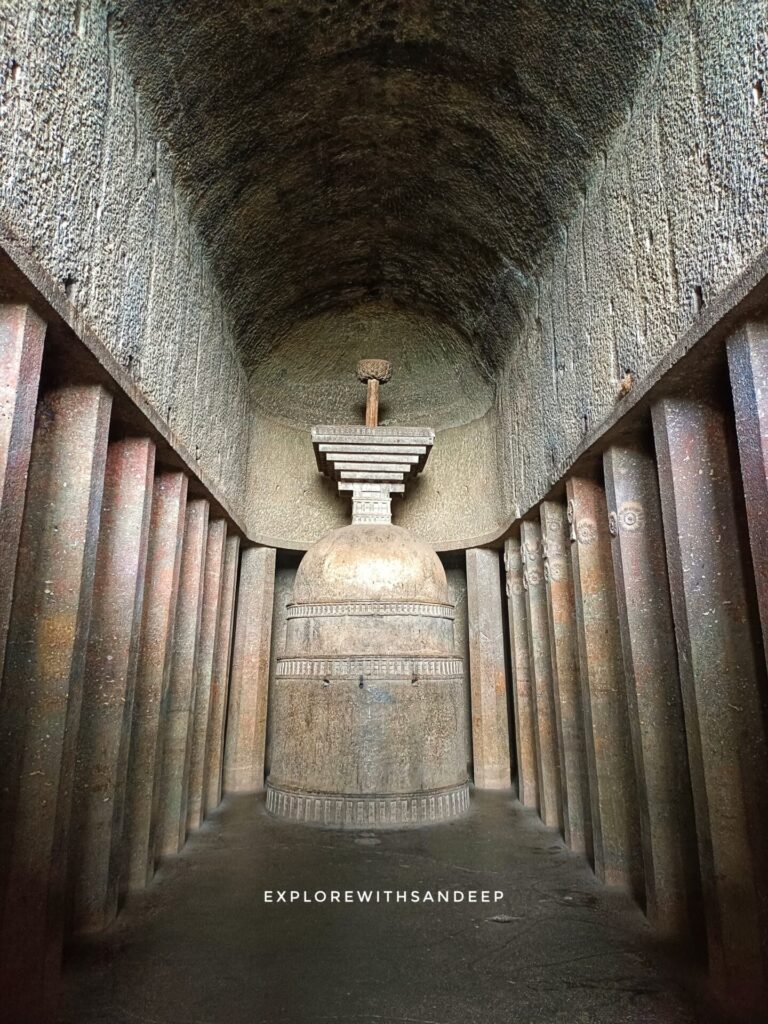
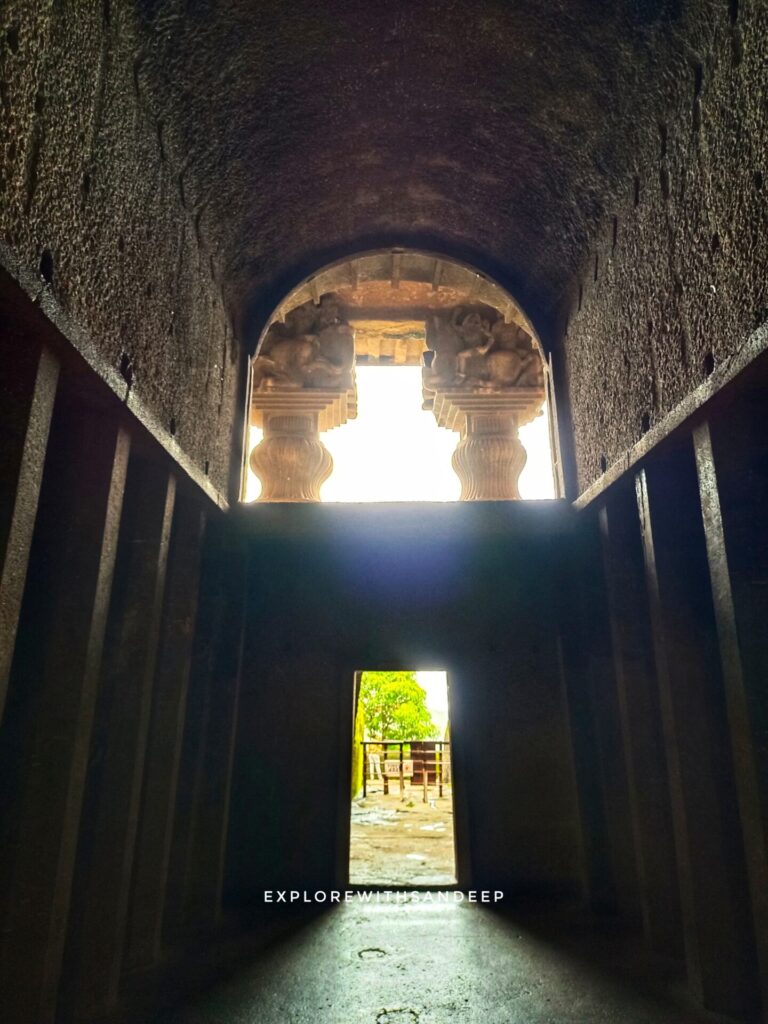
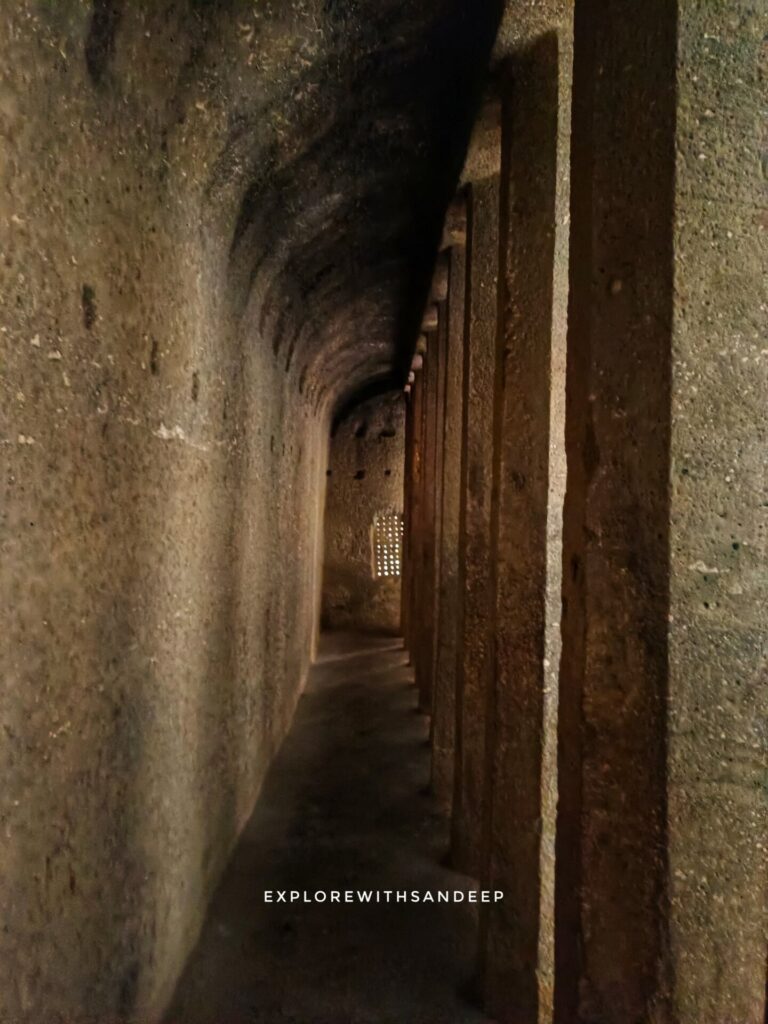
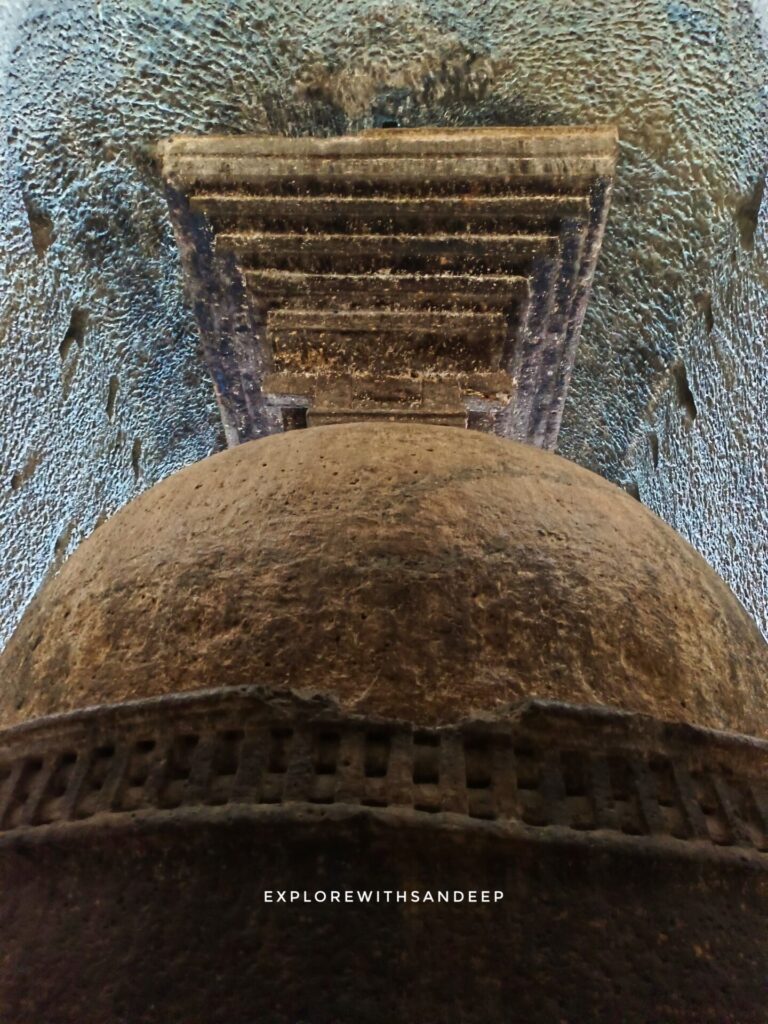

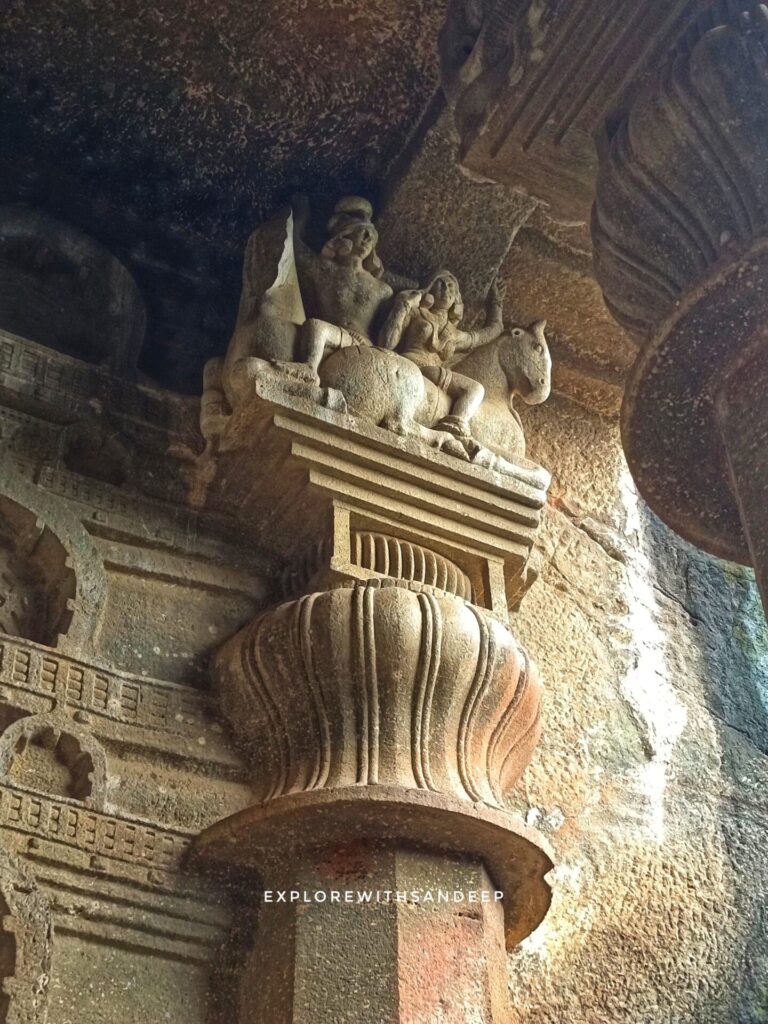
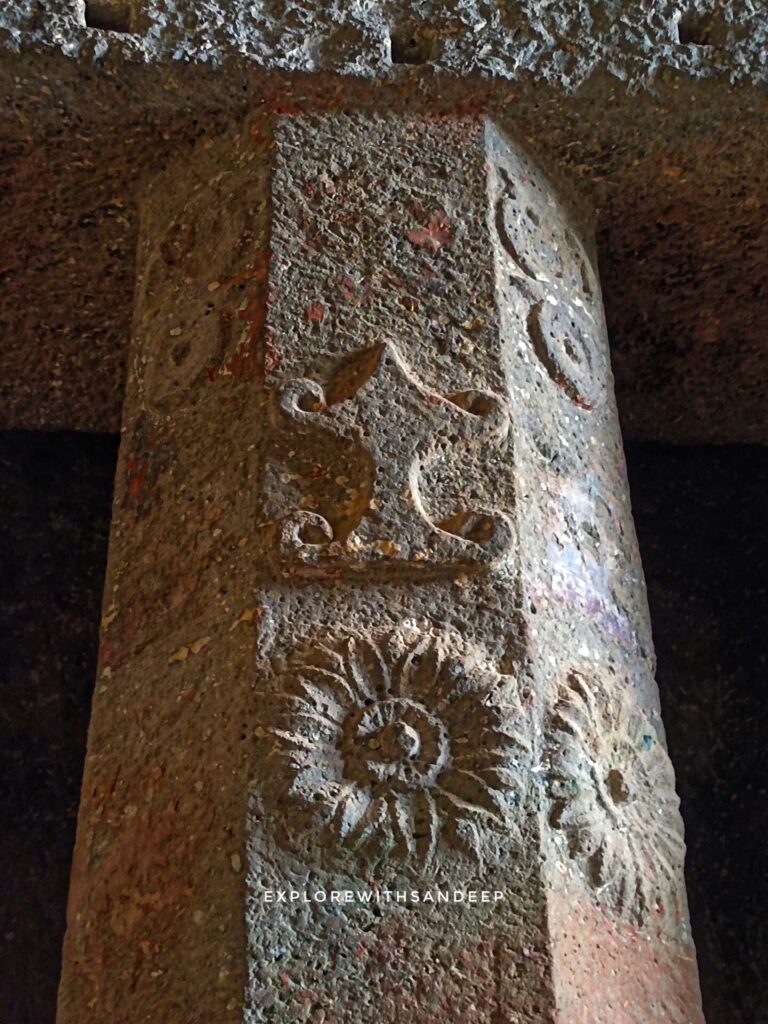

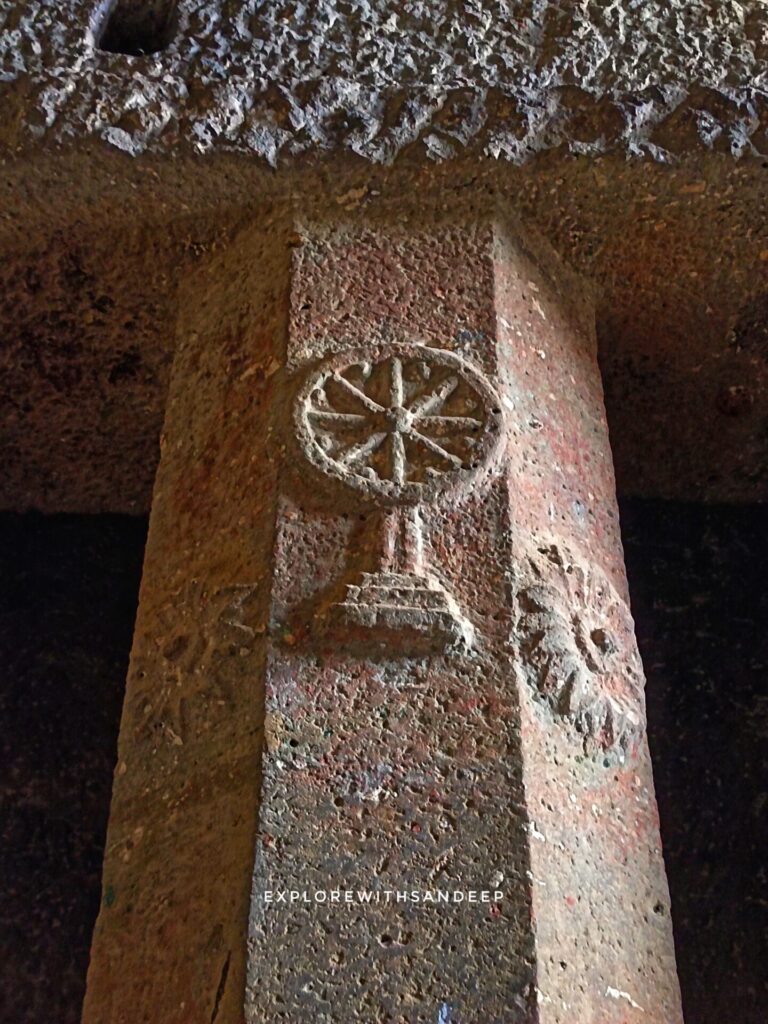
The main door has pierced stone windows, and above the arch, it looks like there are wooden beams — but surprise: it’s all carved from stone! The level of skill in this stonework is just next level.
The hall also has pillars on both sides, slightly tilted inward, which gives it a balanced and symmetric look. This is a classic style in old Buddhist caves.
And here’s the fun bit – some of the carvings on the pillars are real head-scratchers! 😄 One looked like a flower 🌸, another like a spiral or galaxy 🌌, and a few others were just totally mysterious. Maybe they had deep meanings… or maybe ancient artists just liked to mess with us a little!
Meet Santosh – The Wikipedia of Bedse 🧑🏫📚
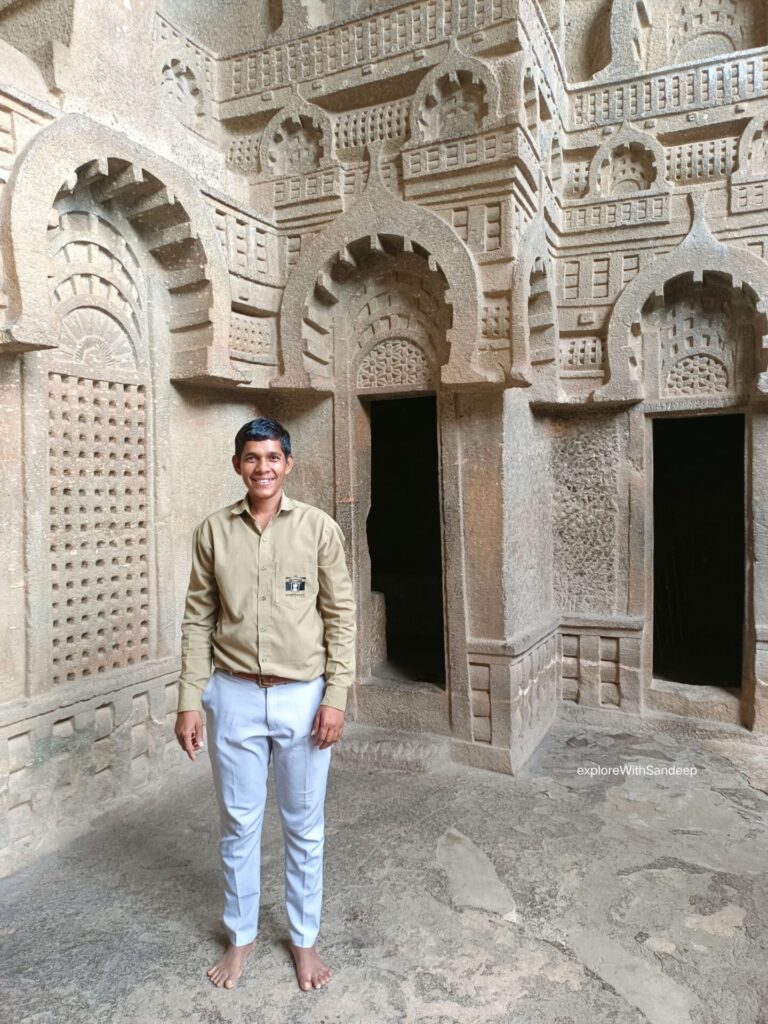
As we sat inside the cave, soaking in the silence and ancient vibes, we met Santosh, the official caretaker of Bedse Caves – and trust me, he’s like the living Wikipedia of Bedse! 😄
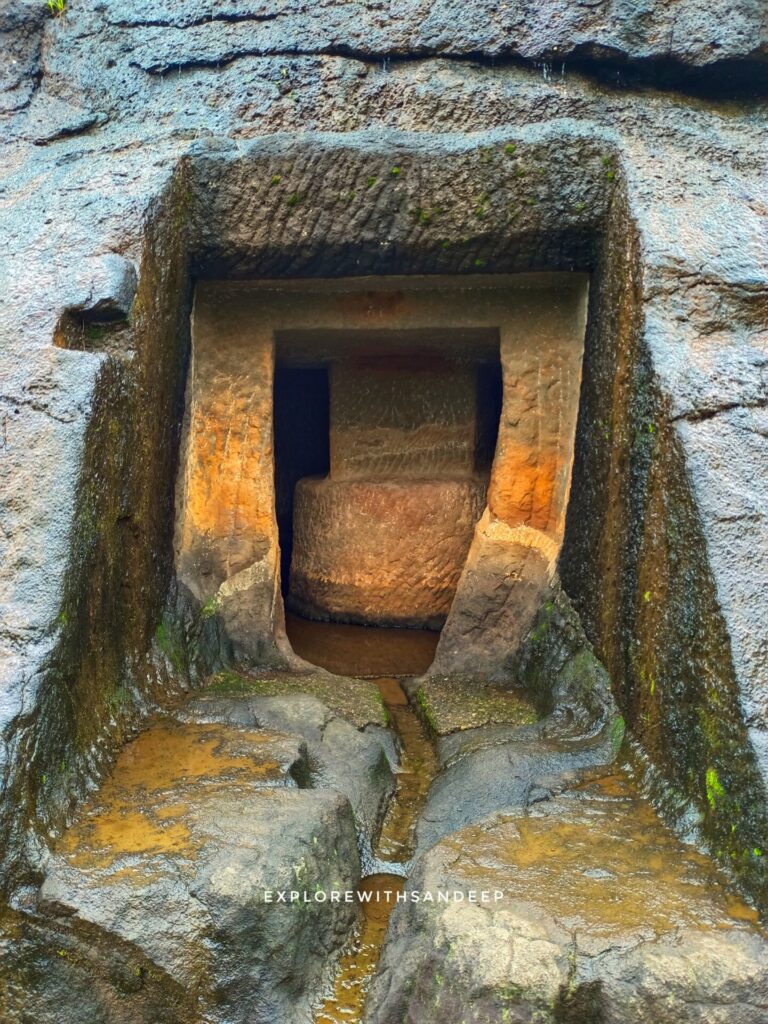
Santosh works with the Archaeological Survey of India (ASI) and has been looking after the caves for years. The best part? He loves sharing stories. He told us how before starting any cave, ancient builders would carve a “test cave” and observe it for years – to see how the rock reacts to weather and time. Only if it passed the test, they would start the actual construction. Smart, right?
He also explained how monks used to live here, meditate, walk around the stupa, and use the stone-cut water tanks for daily needs. We even got to know that Cave 7 was built during the 1st century BCE, at the time of the Satavahana dynasty.
And here’s something I never knew – till the 1800s, British officers used to visit Bedse often, and the local rulers would keep the caves painted and well-maintained just to impress them! Meeting Santosh made our visit even more special. It felt like having a guidebook, a historian, and a storyteller — all rolled into one person.
Cave 11 – The Monk’s Chill Zone (Vihara) 🧘♂️🪔
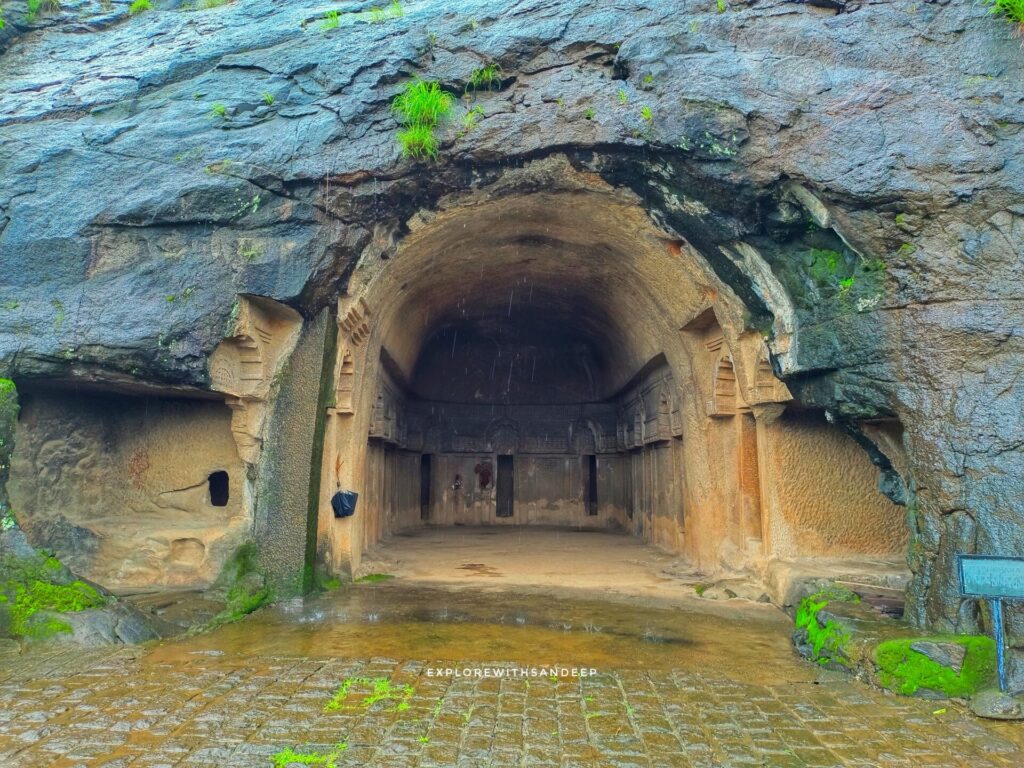
After exploring the grand Chaitya Hall, we walked over to Cave 11, also known as the Vihara – basically the chill zone for monks back in
the day!
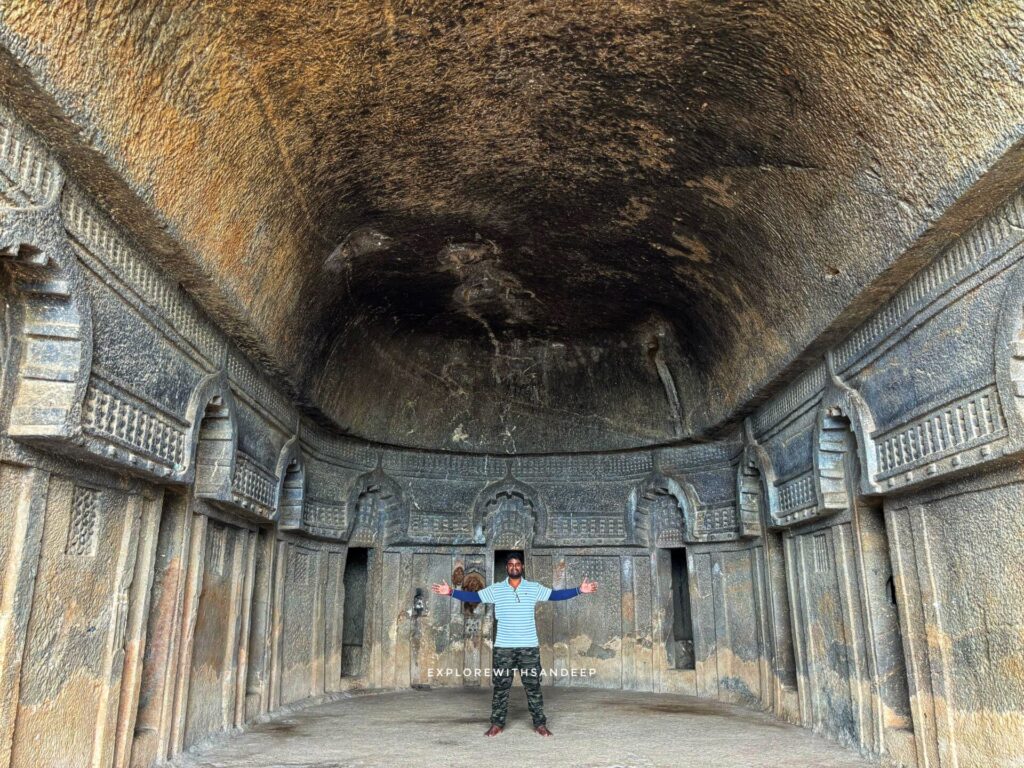
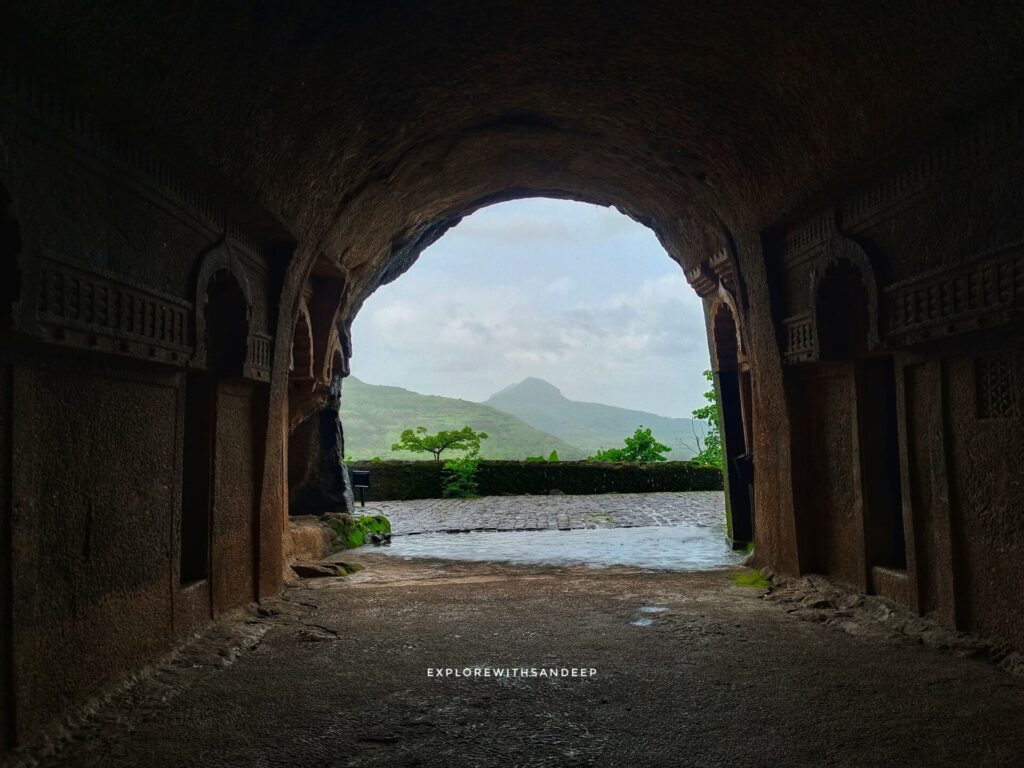
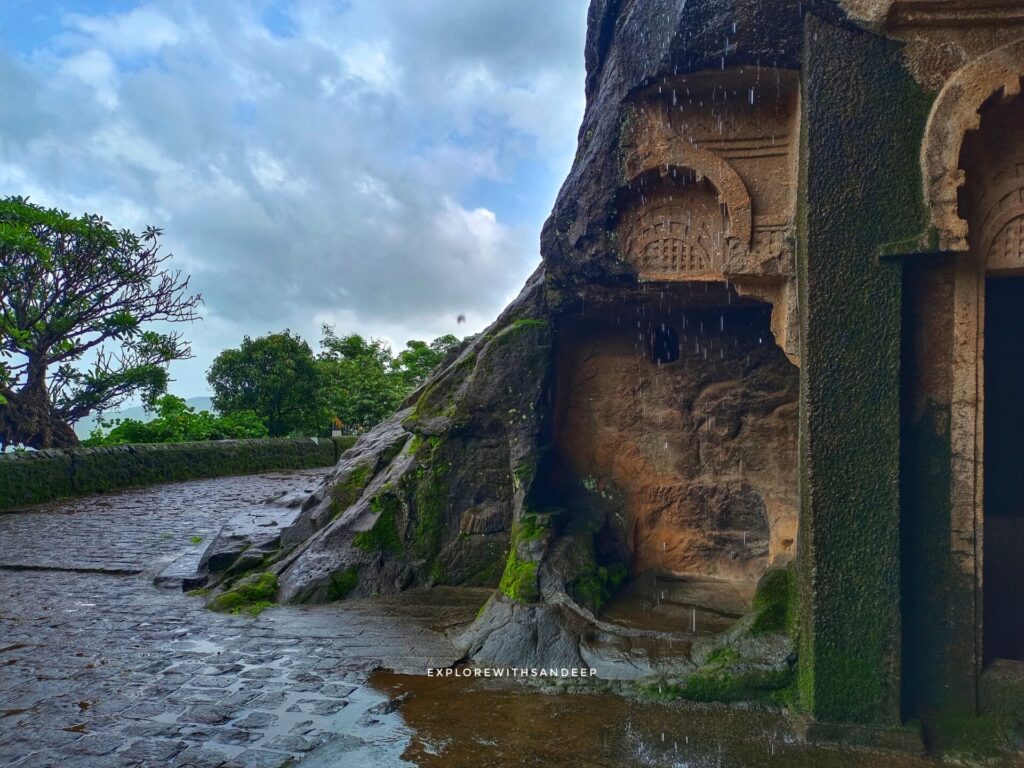
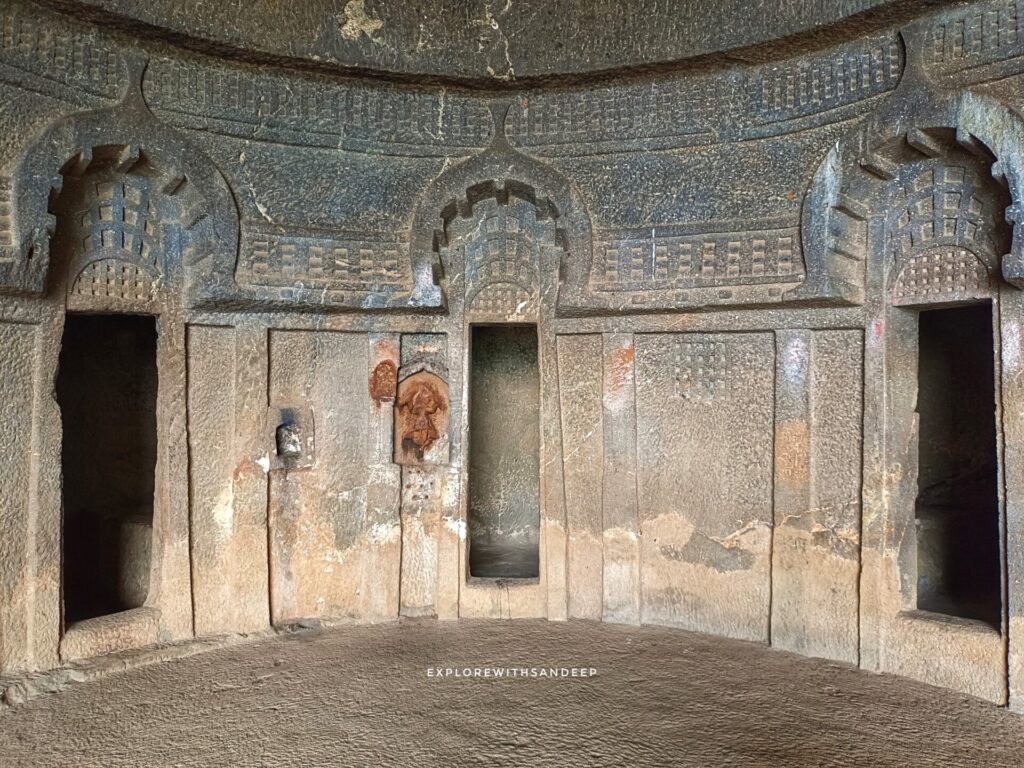
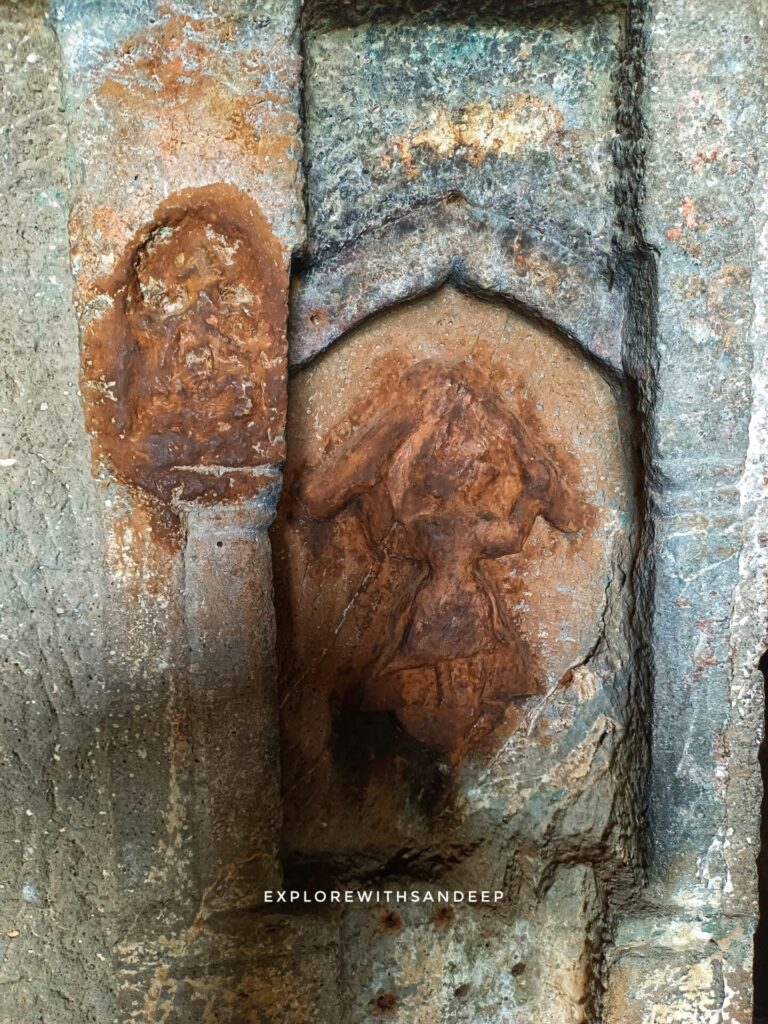
The Vihara has a verandah (front porch) that leads into a hall with an apsidal (rounded) end, and along the side walls are fourteen small rooms carved out of rock. Each room has a simple doorway with arched designs above – neat and clean, just the way monks liked it.

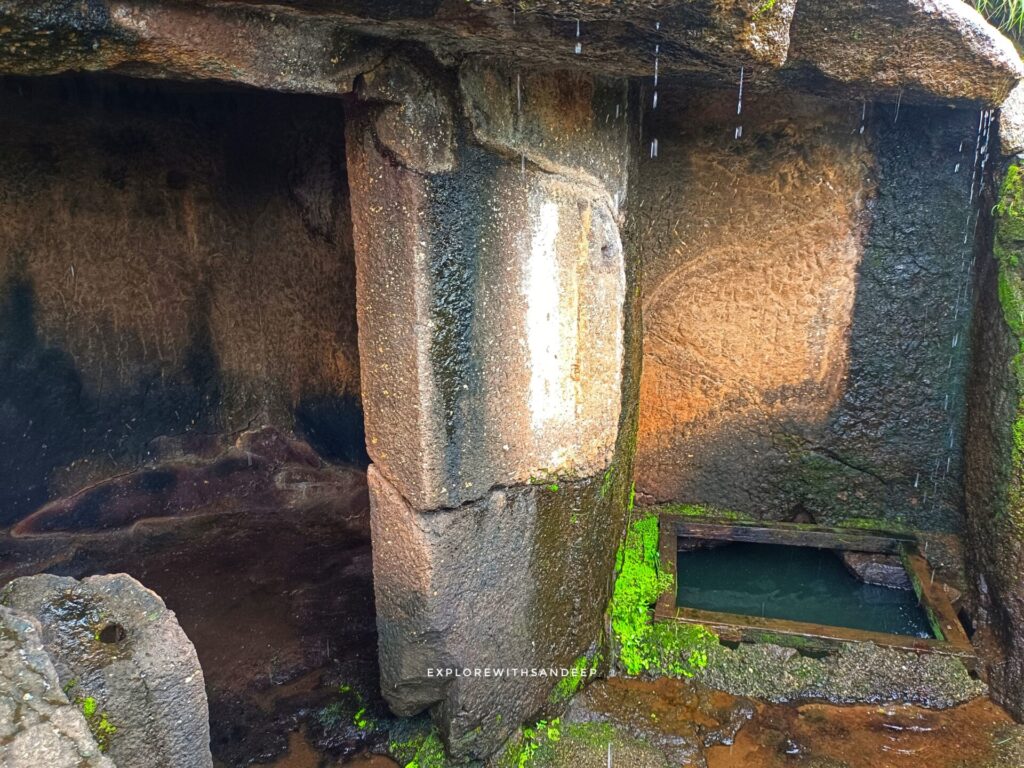
One interesting thing we noticed – inside the Vihara, someone had carved a Ganpati idol and a goddess figure much later, probably by visiting devotees. These carvings are clearly newer than the rest of the cave, but still add to the spiritual feel of the place.
It was peaceful, simple, and very real – a perfect glimpse into how the monks lived and found calm in nature and silence.
Things to See at Bedse Caves
🛕 Chaitya Hall (Cave 7) – The main prayer hall with a huge central stupa, surrounded by
beautifully carved octagonal stone pillars.🐘 Carvings of Riders & Animals – Intricate sculptures on the entrance pillars, showing people
riding elephants, horses, and bulls.🪟 Stone Arched Windows – Pierced stone windows that look like wood but are fully rock-carved!
🌀 Mysterious Symbols on Pillars – Unique ancient designs that still puzzle modern visitors.
🧘 Vihara (Cave 11) – The monks’ living quarters with small meditation rooms and
a peaceful, cool vibe.💧 Underground Water Tank – A smart ancient water storage system carved into rock.
🔍 Testing Cave – A smaller cave used to test the strength of the rock
before building the main structures.🌿 Scenic Views & Peaceful Surroundings – Monsoon waterfalls, village vibes, and no crowds –
just you and 2000 years of history.
Final Thoughts – Is Bedse Caves Worth the Visit? Absolutely!
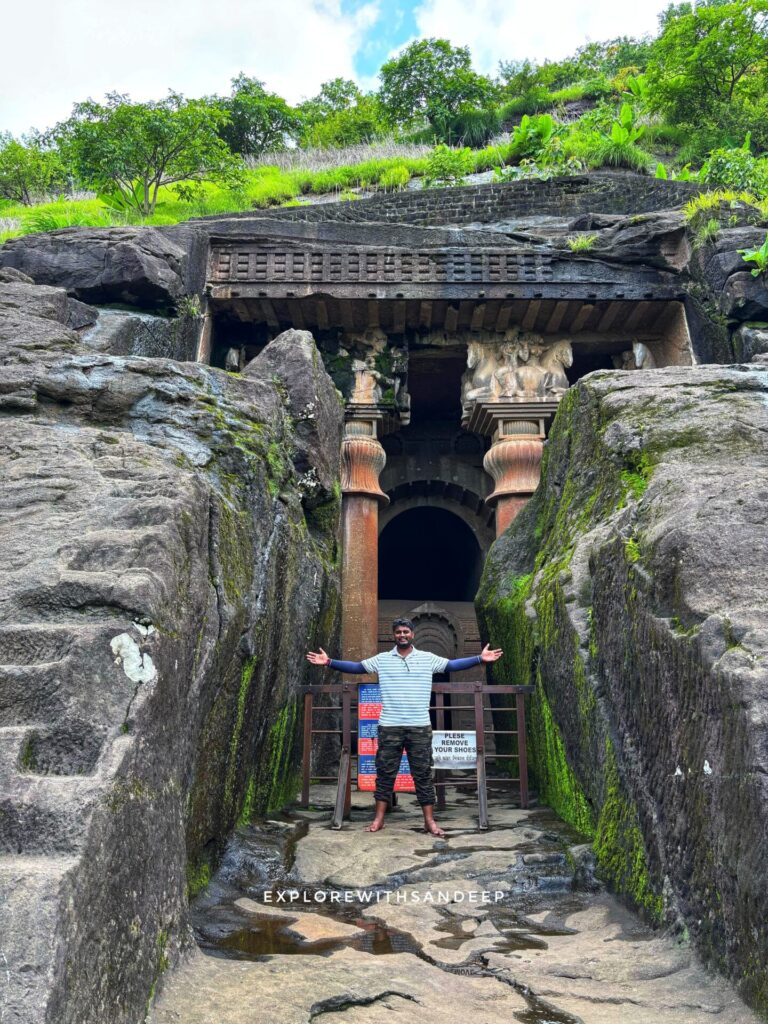
So after climbing 400 steps, walking through 2,000 years of history, and meeting our new friend Santosh (the human encyclopedia), the big question is – was it all worth it? And the answer is a big, loud YES! 🙌
While Karla and Bhaja caves are more popular, Bedse Caves felt special. Maybe it was the peaceful vibe, the fresh mountain air, or the fact that we had the entire place almost to ourselves. It’s quiet, clean, and full of amazing ancient carvings that make you wonder how skilled people were even back then – without any modern tools.
Here’s why I think you should definitely visit Bedse Caves:
✅ No crowd, no noise – just peace and nature
✅ Stunning monsoon views with waterfalls and green hills 🌧️🌄
✅ Beautiful rock-cut architecture and secret carvings 🪨
✅ A real workout with 400+ steps (your legs may not thank you, but your soul will 😅)
✅ Friendly locals like Santosh who make the visit even more special
Whether you’re a history buff, a nature lover, or just someone looking for a calm weekend trip near Pune or Mumbai – Bedse Caves is a hidden gem 💎 waiting to be explored.
So pack your bag, charge your camera, and go say hi to the past – it’s still waiting up there in the hills! 😊
If you enjoyed this travel blog, please leave a comment below 💬 – it means a lot!
Also, if you know of any hidden gems or offbeat places around Pune, Maharashtra, or anywhere in India, drop your suggestions – I might explore it next! 💡
And don’t forget to share this blog with fellow travel lovers. Let’s uncover more amazing places together!
How to Reach Bedse Caves
To reach Bedse Caves from Pune, drive on the old Mumbai–Pune highway (NH4) towards Kamshet. From the Kamshet bridge, take a left towards Pavana Dam. After about 7–9 km, you’ll see a signboard for Bedse. Take the right turn and drive 2–3 km on a rough road to reach Bedse village. Park your vehicle there and climb about 400 stone steps to reach the caves.
If you don’t have a vehicle, take a local train to Kamshet. From there, you can hire a taxi or auto-rickshaw to Bedse village. Shared jeeps are also available sometimes. Public buses are another option, but they take more time and may involve a few changes.
📍 Nearby Places to Explore Around Bedse Caves
🏞️ Pavana Lake – Just a short drive from Bedse Caves, this peaceful lake is perfect for a relaxing picnic, camping, or simply enjoying the serene views.
🏰 Lohagad Fort – A majestic fort near Lonavala with an easy trek and panoramic views of the Sahyadris.
🗻 Visapur Fort – Located close to Lohagad, it’s a larger fort with waterfalls along the trekking path – a monsoon favorite!
🚠 Tikona Fort – A pyramid-shaped fort offering stunning views of Pavana Lake from the top. The trek is short and sweet!
🛕 Karla Caves – One of the oldest Buddhist cave complexes, more popular but often crowded. Features a massive Chaitya and beautiful carvings.
⛰️ Bhaja Caves – Sister caves of Karla, but quieter. Offers caves, stupas, and a scenic waterfall in the monsoon.
🌄 Kamshet Paragliding Point – If you’re up for adventure, try paragliding over the green Sahyadri hills – especially popular in winter and post-monsoon.
🌿 Hadshi Temple – A peaceful and clean modern temple surrounded by greenery, just 10–12 km away from Bedse.
Bedse Caves - Frequently Asked Questions
1. Where are Bedse Caves located?
Bedse Caves are located near Kamshet, around 58 km from Pune and close to Pavana Dam in Maharashtra.
2. How old are Bedse Caves?
These caves are over 2,000 years old, built during the 1st century BCE, around the time of the Satavahana dynasty.
3. How many steps are there to reach the caves?
You’ll need to climb around 400 stone steps to reach the main cave area. It takes around 25–30 minutes, depending on your speed.
4. What is the best time to visit Bedse Caves?
The best time is during monsoon (June–September) or winter (November–February) when the weather is pleasant and the hills are lush green.
5. Is there any entry fee?
Nope! Entry is free. You can explore the caves and enjoy the views without spending a single rupee.
6. Are there guides available?
There are no official guides, but if you’re lucky, you might meet someone like Santosh, the caretaker, who shares amazing insights.
7. How much time is needed to explore Bedse Caves?
You can explore everything in around 1.5 to 2 hours, including the climb, sightseeing, and relaxing at the top.
8. Is it suitable for kids and elderly people?
There’s a steep climb, so it might be tough for elderly visitors or very small kids. Take breaks and go slow if needed.
9. Are food and water available at the site?
There are no shops near the caves, so carry your own water and snacks. Also, avoid littering and respect the heritage site.
10. Is parking available?
Yes, there is a small parking area near the base of the steps at Bedse village.

